Solidly “Strategic”, but the “Mind” is quite mental.
Type: Single-player
Genre: Turn-Based Strategy
Developer: Starni Games
Publisher: Starni Games
Release date: 25 October, 2019

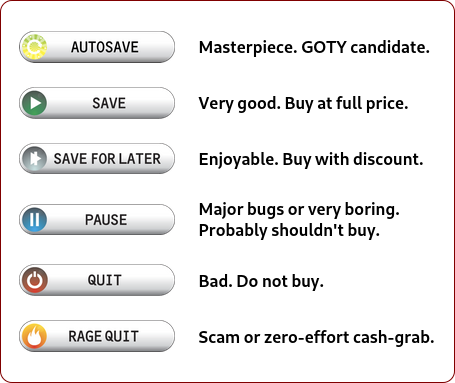
Once more unto the breach.
Panzer General by the now-defunct legends of strategy gaming SSI was a sub-genre defining classic that has spawned many would-be spiritual successors. Panzer Corps is a more modern attempt, for example. Strategic Mind: The Pacific is sequel to Panzer Strategy, clearly in that Panzer General mold, and like how Slitherine decided to make Order of Battle: The Pacific (subtitle later renamed to “World War 2” when its expansions included Europe again) because once you’ve done Europe, you might as well do the Pacific, Strategic Mind is basically the same game but with Japan and a larger naval focus.
In this game, you play as either Admiral Chester Nimitz (American campaign) or Admiral Isoroku Yamamoto (Japanese campaign) through successive historically-related battles carrying a “core” force with you through each battle as they gain experience.
Boot Camp
I’m primarily writing this review for people who already know what kind of game Panzer General’s clones, or to a lesser extent, the more newbie-friendly Advance Wars (“serious” coat of paint aside, there’s a lot in common between the two) are like, since not only is that the perspective I occupy, I can’t imagine many people would even have a lower-profile game like this even appear on their radar if they weren’t interested in the giants. That said, in the interest of accessibility, I’ll describe the basic flow of the game. Genre veterans can skip to the next header.
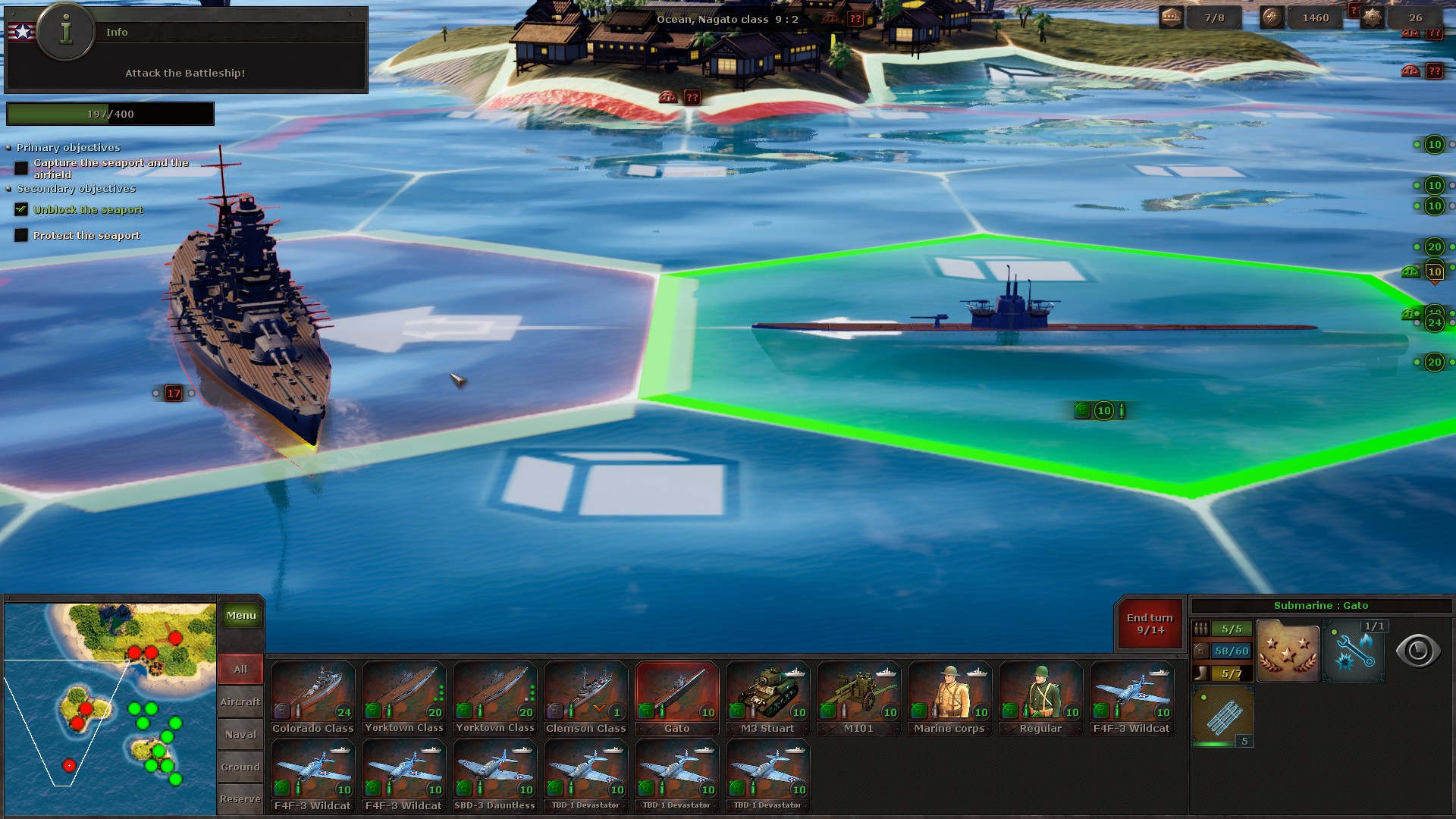
Unlike some of the more “realistic” strategy games, where you move divisions around that have sub-units with various equipment, Strategic Mind is a game where you can have an infantry or a tank or even an anti-aircraft gun unit that is a free-standing unit that takes up a whole hex (although air is another “layer” of map so planes don’t block tanks from using roads like in Advance Wars), meaning that AA guns apparently fight alone and can take up about 1/8th of your whole army. This is kind of silly militarily, but makes for the effective rock-paper-scissors weakness exploitation that the game runs on – infantry can’t fight back against bombers, but AA guns can’t fight effectively against enemy infantry, so you need to keep the two close together, and focus upon striking units with their weakness while blocking off counterstrike by that unit’s own weaknesses.
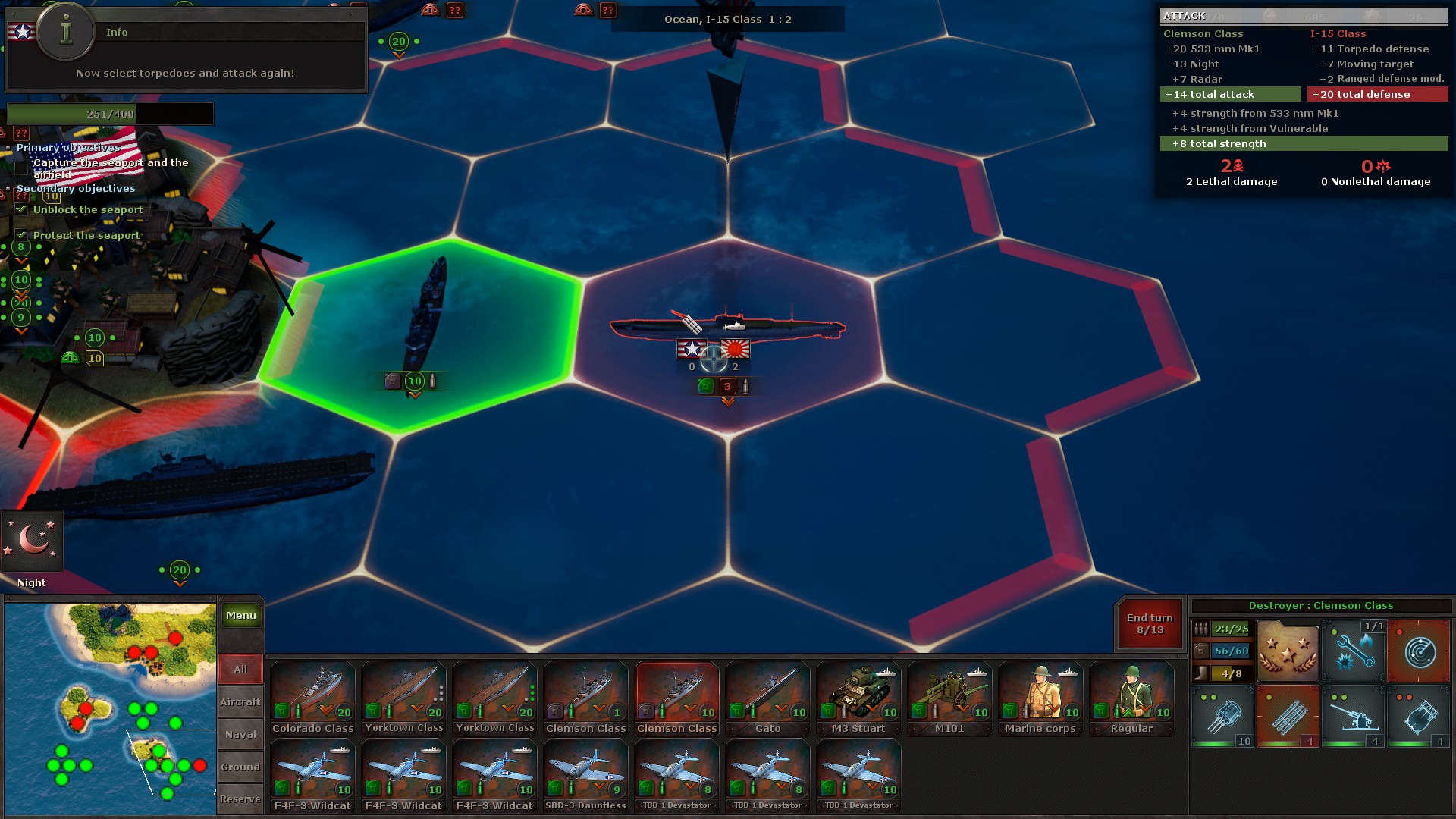
You are often given multiple objectives in the mission, like taking specific cities or eliminating enemy supply vessels (often with some whiff of what historically happened involved), often pushing a hyper-aggressive playstyle. Some defensive missions exist, but for the most part, you are expected to charge forward and overwhelm the enemy before they can mount an effective counterattack, even if it means throwing your men into a meat grinder to do it. (Hey, it’s war.)
Of particular note from the Panzer General bloodline is the notion of “core units”. You are sometimes given non-core units to control for particular maps to help you along that are taken away at the end of a mission, but your core units carry over between missions. As a reward for completing missions well, you get Prestige that is used to repair damaged units (in this game, even non-core units cost prestige to repair before you give them back, so don’t let them die just because they’re not yours) and to buy new core units that you can customize your force with. Core units also gain experience and eventually become significantly more powerful than normal units, but only if you keep them from serious harm. This creates a snowballing effect where doing well early on gives you more prestige to buy more and upgrade your core units that lets you do better in later missions, while bad performance that results in destruction of core units means you may as well reload now, because if you lose your last core unit carrier, you basically cannot win future missions without buying another one, and paying for that instead of new aircraft to defend the carrier is just digging a deeper hole from which you’ll never climb out.
Core units can create something of a problem in terms of the scale of battle, however. This isn’t as obvious for land-based battles like the original Panzer General, but in Strategic Mind, for either campaign, you start the game with both a battleship and a carrier full of aircraft. This means that every battle you fight will have battleships and carriers, even if the historic battles you are re-enacting had no such thing, as most of the early battles of the Pacific were mostly cruisers and destroyers fighting at night to avoid the interference of land-based aircraft. It escalates the intensity of every conflict to have every battle be a carrier battle, since you can’t have the opponents of a carrier task force just be half a dozen destroyers anymore if you want to have any kind of strategic challenge. With the limited number of unit types, you can often sink half a dozen Nagato-class battleships in a single battle when there were only two ever built in real life.
The Competition
With the basics out of the way, I’ll now indulge in comparisons to its direct competition, especially Order of Battle’s original Japanese Navy and American Navy campaigns because they not only cover the same theater of war, even most of the same battles, but even copy their mechanics from the same ancestor, so they are about 85% the same game which makes their differences stand out more. The Japanese campaign for both, for example, starts with Pearl Harbor and then goes onto the invasion of the Philippines, although Order of Battle’s version splits conquering Luzon into two battles, a north and south half. In what was historically a battle that really did take months, the slow slog southern portion is a second battle in Order of Battle, but it’s a speedy mop-up in Strategic Mind as Yamamoto laughs at the claims from Gen. MacArthur that they will be able to hold out before sinking MacArthur’s destroyer before he can escape the Philippines to return and reclaim them one day.
This brings me to the three most obvious differences between the two games, which is the size and time scale of the games.
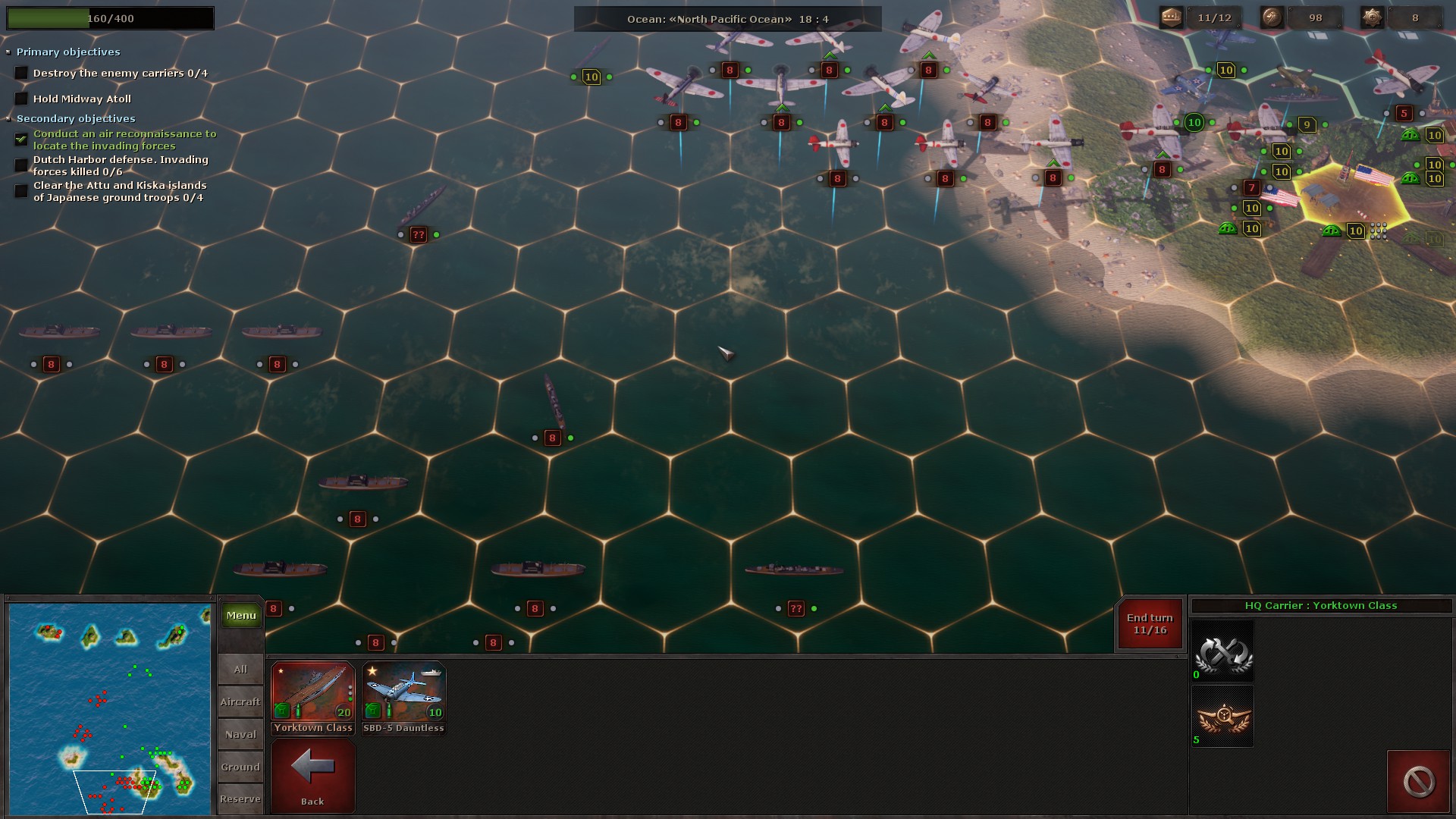
The difference between the Battle of Coral Sea in Strategic Mind and Order of Battle is that Strategic Mind’s version takes up about 1/10th the area of Order of Battle’s, and you have about 1/5th as many turns to complete the mission. These two major differences are likely the result of that third reason, which is the utterly unnecessary detailed 3d graphics courtesy of the Unreal Engine this game runs upon. There are, probably for technical reasons, less units in smaller areas that wind up fighting shorter battles because of all this focus upon making pretty 3d models the competition didn’t waste time and money building since it’s a strategy game, nobody cares about the unit models.
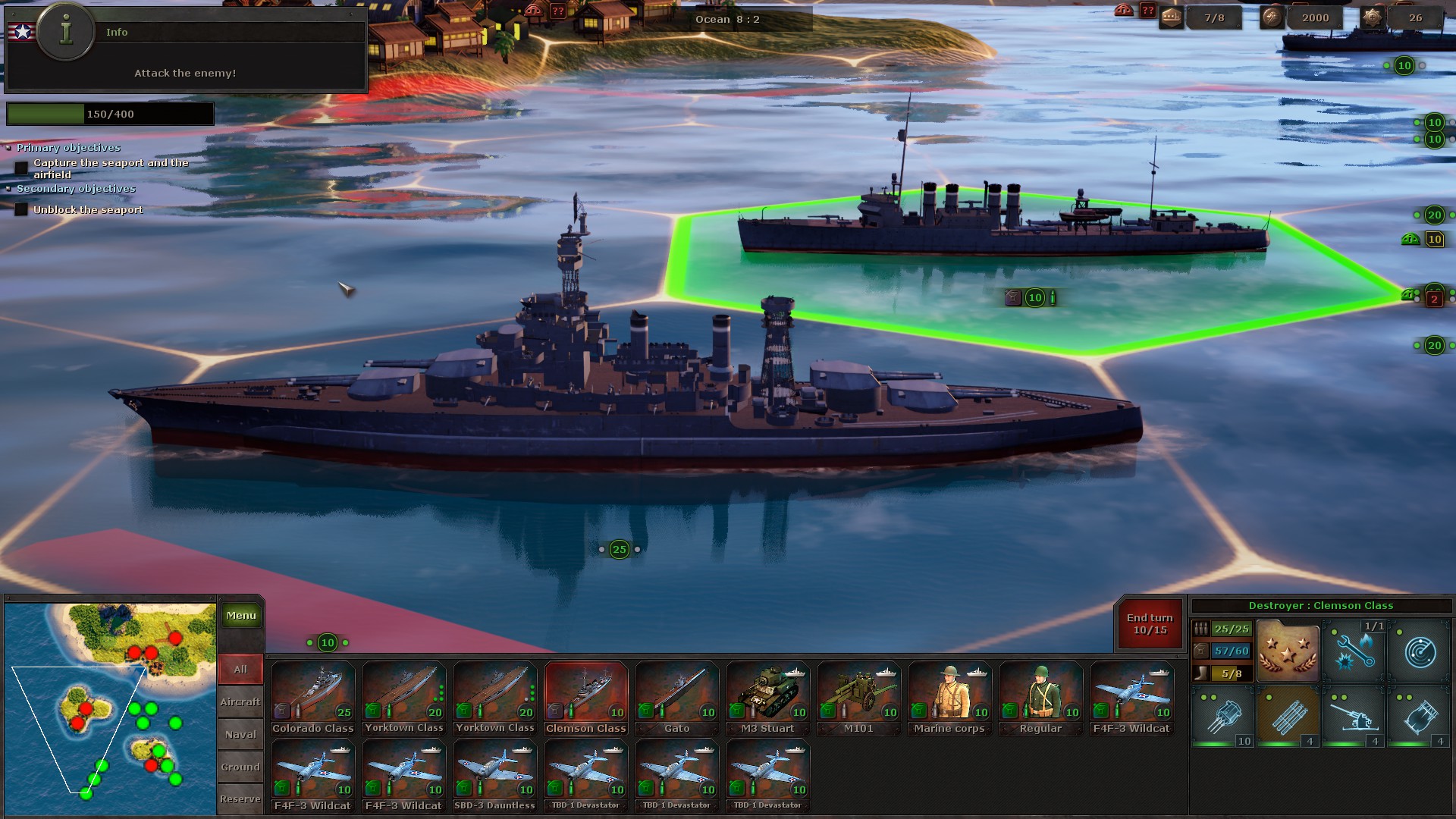
Because of the difference in time scale, Strategic Mind frequently has you performing significantly more actions with a single unit per turn than Order of Battle does, and expects battles to end in significantly less turns. A couple of major stand-out examples is that most weapon systems on ships can be fired more than once per turn. A destroyer can fire up to seven times per turn (two main guns for surface targets, two AA guns for air targets, torpedoes for naval targets (including submerged submarines despite that not working historically), and two depth charges) on top of being able to move and use sonar once per turn as one example. Also, aircraft can only attack once per round, but it is possible to land and take back off fully refueled in a single round. (It doesn’t even take movement points if you have a special ability!) By comparison, Order of Battle impressed upon the player the deliberateness of carrier operations by not simply not allowing aircraft to land and take off in the same turn, but you were limited to either take off one aircraft or land one aircraft per turn. If you wanted to mass your flights of aircraft, you needed to have them loiter in the sky above your carrier for their buddies to get up there with them, and you needed to triage returning aircraft by which ones are about to fall out of the sky from lack of fuel.
The most major example of how this changes the game is probably the Battle of Coral Sea. In the historic Battle of Coral Sea (the first carrier-versus-carrier battle in history), both sides made bad assumptions about their opponents, searched for their enemy in the wrong place, actually sailed past one another, found and attacked the wrong targets, found out where the enemy really was by the distress signals of their allies, and then finally fought each other to a stalemate before mutually retreating. Order of Battle represents this by having a positively massive map (Coral Sea is basically everything North to East of Australia, after all) with a turn limit of IIRC 44 turns, and telling players that reconnaissance is the key to battle. Even fast recon planes take four or five turns to reach the areas you want to sweep, and need refueling. They even have several “wrong targets” out there that show up on radar, but are just relatively pointless destroyers or supply vessels if you run down to identify them. The game suggests you can use your fighters or even bombers to search, but if they do find something, bombers are sitting ducks for enemy combat air patrol, and fighters will be unavailable to protect the fleet if you send them out. Strategic Mind, however, just makes enemy units teleport in directly in front of you and has small cutscenes to show you exactly where to send your recon planes, which are a special command power that teleports to exactly the spot you want revealed. The Japanese “wrong targets” are rewritten to have always been your target all along because you now know they were there somehow, and the “wrong targets” on the American side, the fueling tanker that was sent south to escape battle but hit by enemy bombers after being mistaken for a carrier is now a supply convoy apparently coming up from Antarctica that gets deliberately attacked by the Japanese even though your position was already revealed and the carriers that should have launched those planes are already sunk.
One thing I really do appreciate about Strategic Mind’s level design, and something I found deeply disappointing about Order of Battle’s original campaign level design, however, was the combined-arms operations. In Order of Battle, you just start off already landed on Luzon island in the battle for the Philippines, and all your naval units are just shoved into storage for those missions until it’s time to let your navy actually participate in the “navy campaign”. In Strategic Mind, you have to actually manage the landing yourself, and can start off by having your carrier send out aircraft or your battleships, destroyers, and carrier bombard the coast.
Oh, yeah, about that last one, did I mention that your carriers get deck guns and the game even outright tells you to charge your carrier into battle to fire upon things in the tutorial? Because they do, and it’s just bizarre. It’s even a key strategy to success in the Pearl Harbor mission to make sure you bombard the coast with your carriers to blow up planes on the ground while your aircraft attack inland targets!
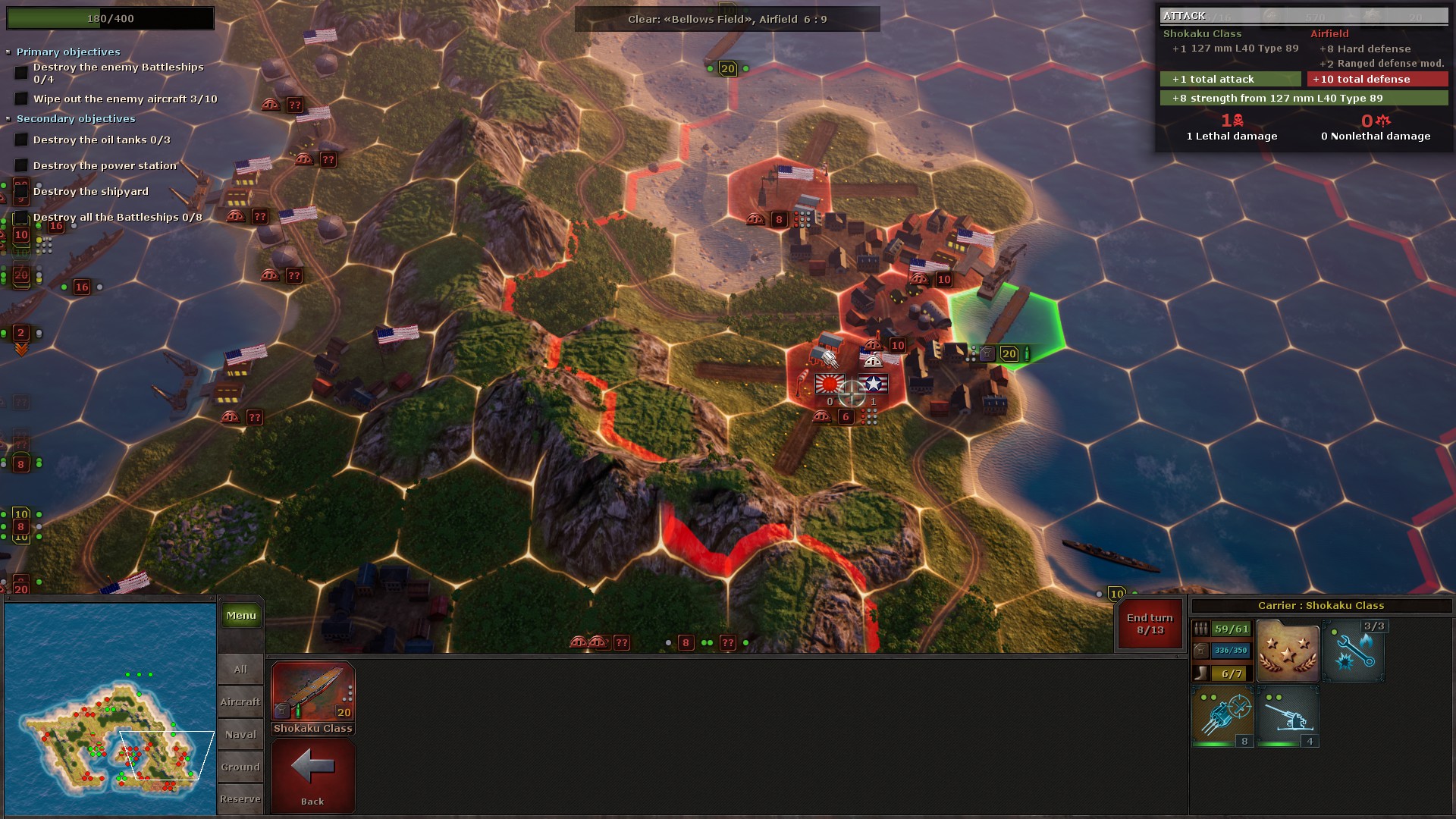
Another key difference is how units are repaired:
In Order of Battle (as with most of these games), you can repair units at a city or airfield or dock as appropriate, and a key part of longer battles is to keep cycling in units that are damaged to the places they get repairs, but at the same time, repairs cost the same prestige it takes to buy new units. Hence, you have every reason to make sure that the only units that get damaged are the cheapest ones, like infantry and destroyers because even if a battleship and a destroyer takes the same damage from a torpedo attack, it costs ten times as much to repair the battleship. This means in naval battles in Order of Battle, you need to set up a repair ship behind your lines and repair destroyers that go out in a cycle to eat damage for the battleships which do the actual killing. Worse, upgraded destroyers and infantry will often cost twice as much prestige (and hence cost twice as much to repair) while only having negligible +1s to attack power, so you never want to own the upgraded forms, and at key points they even stop selling your cheap destroyers and infantry, so you have to stock up on the cannon fodder while it’s still cheap and keep them from being destroyed (but still in harm’s way because SOMEONE has to get hurt in a war).
Strategic Mind, meanwhile, has naval units that repair anything but hull damage automatically (and an Emergency Repair skill a limited number of times per battle that repairs more non-hull damage instantly), while hull damage can only be repaired between missions. This is because each weapon on a ship has individual hit points and take damage individually. You can even have dive bombers target specific components, like the AA guns so that torpedo bombers can attack more easily. This hypothetically opens up a range of possibilities for how to attack dense formations of enemy units, but often winds up enforcing a specific optimal attack order where you use incendiary weapons to damage components first before using torpedoes and armor-piercing rounds to sink damaged opponents.
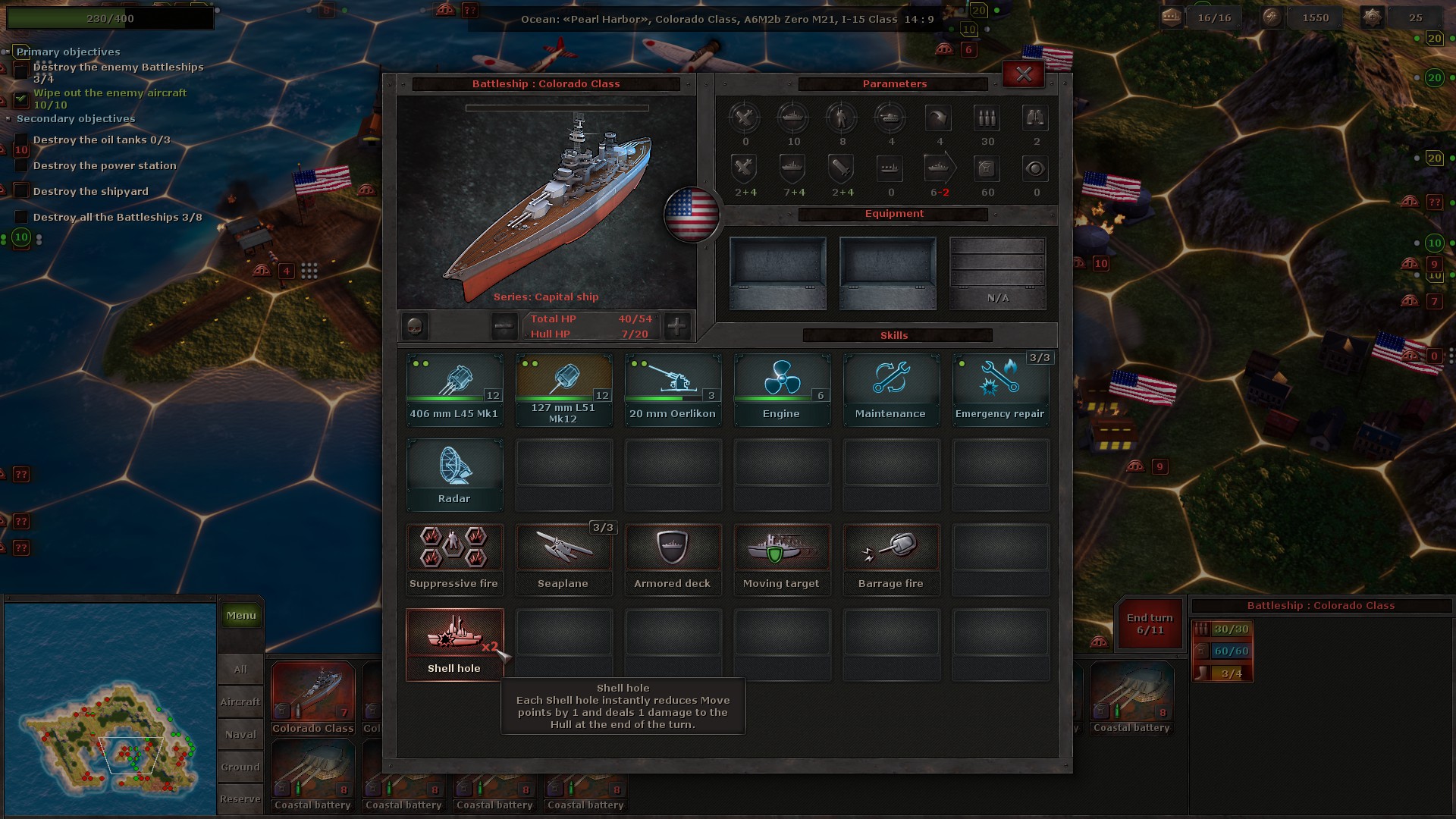
It’s worth mentioning that strategy games at sea (or in space) have a major problem in that, while land battles can always be made different by changing the terrain because a wide open desert is entirely different from a narrow mountain pass even if the units are the same, all stretches of open ocean are basically the same. (Just ask World of Warships players.) The only differences in naval battles away from islands are the unit compositions and formations, and the latter only really matters when you have enough units spread out enough to make it really matter. Strategic Mind has less units in smaller spaces, so it’s added in this greater detail on individual units to try to help make up the difference, but it’s questionable how much longevity it has. Much like how all open oceans are the same, so strategically, it’s never really a different battle, if you’re going in with mostly airpower, you’re always going to want to target AA guns first, so it becomes something of a hollow option. You can pick the obvious right choice based upon your unit composition or be wrong and take damage for no reason; It’s not exactly a thrilling strategic decision, is it?
That said, the constant conveyor belt of cycling cannon fodder in for repairs then back out to sponge damage is probably much more annoying and takes one further out of the strategic mindset overall, so I guess I’ll give this one to Strategic Mind, as well.
Instead, battleships in Strategic Mind basically do not take hull damage from destroyers outside of torpedo attacks, so the game pushes you to use them as the damage sponges. That said, I found that giving destroyers smoke generators almost makes them invincible, so I personally recommend that.
Another major difference is that Order of Battle has “suppression” while Strategic Mind has “non-lethal damage”. In effect, they are similar in that they are temporary and easily repaired damage that nevertheless temporarily weakens a unit, but what’s different is how common they are and what causes them. In Order of Battle, artillery and air attacks on ground units (especially fortified ground units) deal almost no lethal damage, but is nevertheless useful for softening targets for the infantry to overrun the shell-shocked survivors. In Strategic Mind, these attacks do primarily lethal damage, meaning it’s possible to completely destroy dug-in infantry battalions entirely through naval shelling even by mere destroyers (or carriers), and land units are merely there to step on the cities and claim them once everything else is dead. This dramatically shifts the power towards certain units like tactical bombers, artillery, or destroyers, as they can inflict massive damage on land troops without receiving return fire. Combine this with the really small maps, and whereas naval bombardment is useless in Order of Battle even on islands like New Georgia that have thirty or so tiles inland while having battleship gun ranges of six hexes, Strategic Mind islands are more like 10 hexes deep while also having battleship gun ranges of six hexes, so battleships are more useful in land battles even before dealing with their bombardments being more lethal overall.
This is exacerbated further by the excruciatingly annoying “overwatch” feature in this game. Basically, units without the Scouting ability can only move once per turn no matter how many movement points they have left over. They also don’t get to reveal fog of war until having already moved, so you better know what will be where you’re going beforehand. (This makes scouting units very valuable, too bad they’re cheapened by being so cheap.) If a unit has the “overwatch” feature, however, it will trigger and allow that unit to attack the target as soon as it enters range, causing the unit to stop and basically lose the rest of its turn. AA units get overwatch against air units, which basically stops bombers dead in their tracks and make them float stupidly like they crashed into a mid-air wall of glass. Worse, if you only have air units (like at Pearl Harbor), you basically can only deal with this by having fighters strafe them because only fighters get an activated ability (meaning you have to know the overwatch AA is there and use it on purpose) and aim for where the AA gun is to attack it and make it lose overwatch for that turn. Your own units get overwatch, but unlike the AI one, it only works once per turn, and you generally have more than one bomber coming at you at a time. It is, however, still kind of funny to watch dive bombers stop and stare blankly at you after slamming into your invisible overwatch force field that stops them in their tracks.
Samurai Ubermensch
As a general continuation of the trend of “less units, but each has more abilities”, one notable difference is that leveling units up doesn’t just give them a bonus to morale or attack power or something, it instead gives you your choice of one of a set of about 5-8 skills, depending on unit type. These can let units train for night operations or bad weather, halving negative conditions, giving defensive support units more range to support other units or a bonus to submarine evasion based on being near another submarine, or give new limited-use abilities like “Forced March” letting you move infantry two extra tiles in one turn up to twice per battle or “Boom and Zoom” letting a fighter plane get the first attack up to three times per battle. Depending on the situation, these can be anything from worthless to overpowered. What really hurts this as a strategic choice, however, is the fact that the choices are permanent. You basically get stuck with a situational skill boost and just kind of have to hope for that situation to come around a lot.
Something much more interesting strategically, however, is equipment. These add additional abilities that can be minor but globally useful like giving machine guns to infantry to give a +1 damage to other infantry or rocket launchers to handle tanks or the always-useful field medics that reduce incoming non-lethal damage, extra fuel or ammo, as well as limited-use active abilities like mortars or incendiary bombs. These significantly change how well your units can perform in battle, and they can be actively changed out at any supply point appropriate for a given unit. It doesn’t even take any time or movement points to swap out equipment and in a somewhat disappointing turn, you can even do this on a supply point that has been destroyed and/or just captured by your side. I first made a mistake of giving my “rikusentai” marines transports that meant they couldn’t make amphibious landings without an intact port, only to find waiting for repairs for the port to take far too long. If I’d just left the trucks behind, I could have marched ashore then gotten trucks on my marines when they moved near a town to bypass the wait! Equipment does cost prestige, sometimes enough to buy a whole new unit, but they can be exchanged with no loss of value, so you can feel free to swap in and out situational equipment as the situation changes. Some equipment, however, (like aircraft radar or dazzle camo patterns on ships) cannot be switched out mid-mission (which means you cannot put them on non-core units at all). Additionally, some types of units, like submarines, can have up to three slots for equipment, but only three pieces of equipment, so the only choice is whether it’s worth the prestige to take them.
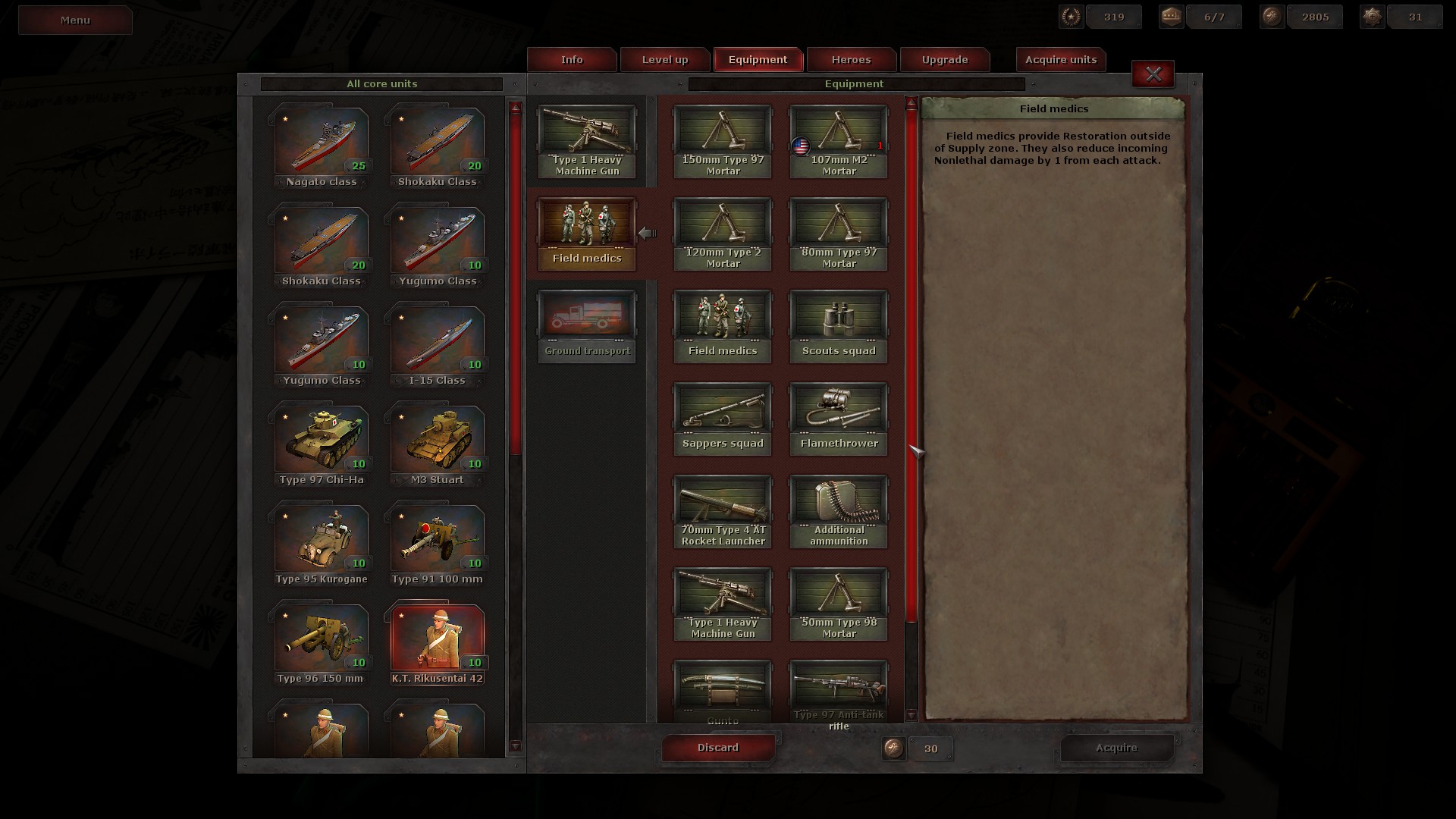
Finally, you have an admiral upgrades section. This gives you the ability to use another special currency, command points, to use special abilities. These range from global passive buffs to your units, like being able to go from having two to three equipment slots or giving all your units an extra level to gain a level-up perk (even non-core units start out with an extra level you can get a perk for), to sending out a reconnaissance aircraft that teleports to the spot you designate, to allowing your artillery or battleships to fire an extra attack per round. These are powerful, although command points are a shared resource between all of them besides the passive boosts, so I tend to favor the passive ones so as to give me more flexibility to use the active powers that are most useful.
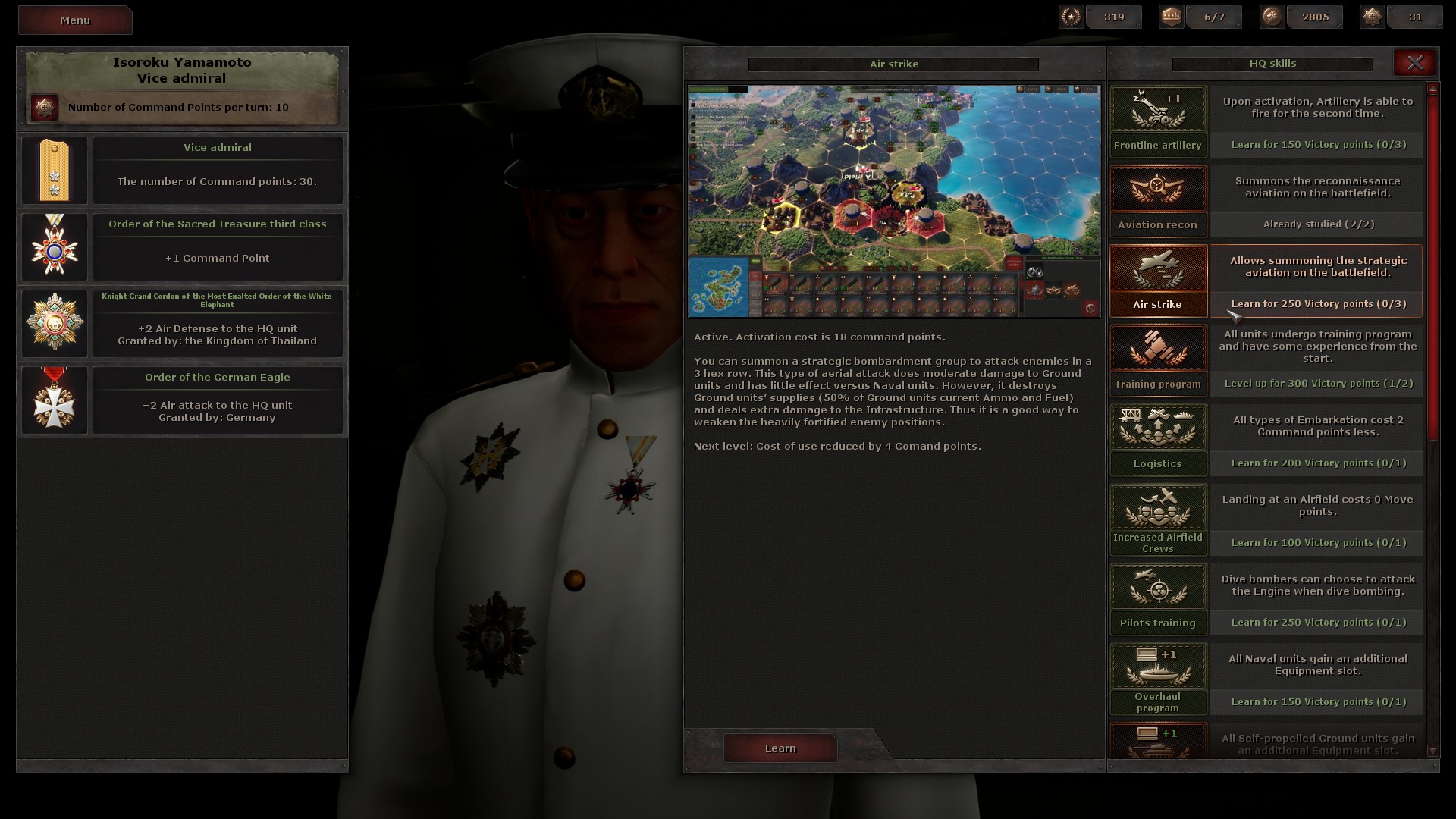
The currency you buy these upgrades with, however, is not prestige, but victory points that you gain only from winning missions, with more victory points being gained if you complete secondary objectives or take all the cities or kill every enemy unit.
Command points are also interesting in that your cap is determined by rank (which is determined by total victory points gained over the course of the game), and how many command points you regain is your cap minus how many core units you have deployed. At the beginning of the game, for example, you have 25 command points for your rank (going up to 30 after your first promotion), but you will have 8 or so core units, so you gain 17 per round. At first, you only have reconnaissance aircraft (which take 5 command points each time you reveal a part of the map) to spend them on, but with command abilities like that “your artillery fires one more time” costing 14 command points per use, it becomes precious fast. More interestingly from a game design perspective, it indirectly punishes buying lots of cheap units the way that Order of Battle inadvertently rewarded it through their repair mechanics, since flooding the map with cheap units cuts your command point regeneration.
Interface and Bugs
First of all, this is yet another indie game that does not allow you to rebind keys, and there’s still no excuse for that. Especially since there are so few keys to even use in this game! Everything works by left clicking on the mouse, everything. This is one of those stupid strategy games that makes you left-click to select units, left-click to move units, left-click to attack, and even left-click to change weapons. Right clicking just brings up an info screen (which you can also view through left-clicking on a button). Notable is that, even though destroyers get to fire up to seven times and use five different abilities (besides movement) per turn, each and every one lacks a hotkey, so you have to click it from the unit status panel. Further, due to the presence of “layers”, but lack of a button to exclusively click on air units or the like that Order of Battle at least features, it’s a real mess to do things like make an air unit move into a hex over a ship without clicking and selecting the ship. There is no “undo” button besides loading a save in this game, so I sure hope you quicksave religiously before every move, because there have been frequent cases of my unit attacking the wrong target or moving when I wanted to attack, much less stupidly opening up a worthless status menu of the grassy terrain when I wanted to move because right click should be the move button, damnit!
Also, while it does have a tutorial of… moderate utility, I want to mention here that the game has a “manual” that is only accessible in-game and is basically just a pop-up text file that tells you what was in the tooltips of various other parts of the game. There is absolutely nothing that actually would help a new player learn the game, here.
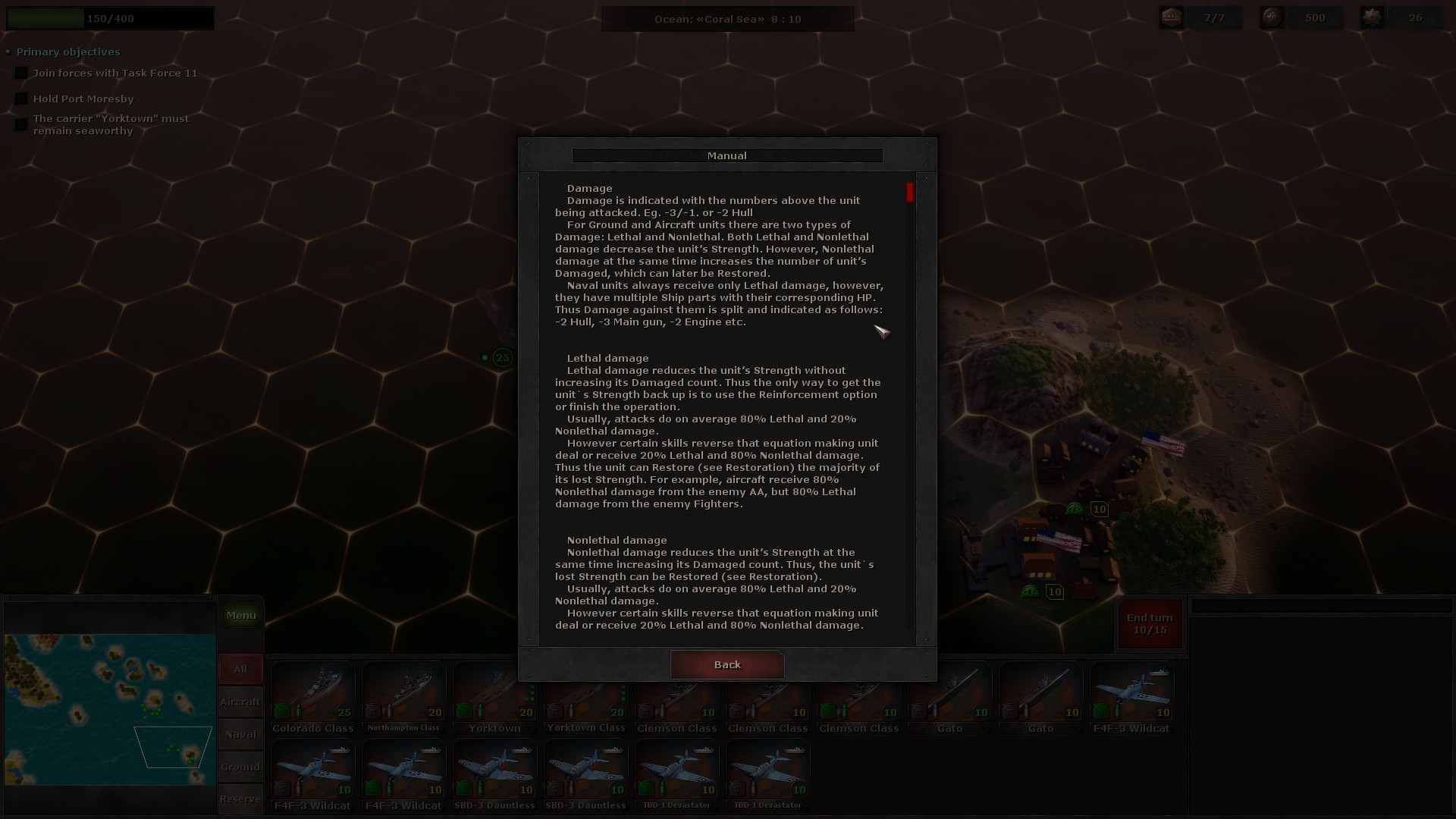
Another major problem is that units move veeeery slowly. There are of course no options to increase unit movement speed (something most strategy games this game copies do offer, by the way), and it can take something like fifteen seconds for a slow-moving plane to travel its 15 hexes. This is especially annoying with enemy turns, where enemies take time to move even while invisible to the player, and you have to sit through dozens of units being shuffled around. Some of the attack animations are just ludicrously slow; depth charging takes about 10 seconds, and remember, you’ll do two of them against a submarine per destroyer, and probably four total on a sub to kill it. You can click to speed things up, but then you’re not going to see who is doing what or how much damage you’re taking if you click too fast. Sometimes, I just have to stop and realize that hey, that unit is gone now, it probably was ganged up upon and died during an enemy turn.
Clicking to skip through the wait time for movement and attacks also can be dangerous because, once again, everything is left clicking, so clicking through the animation for a plane moving then the animation for the plane landing and then accidentally one more time means the aircraft takes back off and spends all its movement points going somewhere useless or outright dangerous! That’s just the game’s way of saying screw you for not wasting your time watching their lovingly barely-animated nonsense taking ten times longer than it should.
Speaking of things that take way too long to show you nothing, the game wants to show off that Unreal Engine and overly-detailed models they spent inexplicable amounts of time and effort upon. There’s an option to turn off the zoom-in to see every attack, but that option is ignored when another unit fires in support of an attacked unit or when overwatch activates.
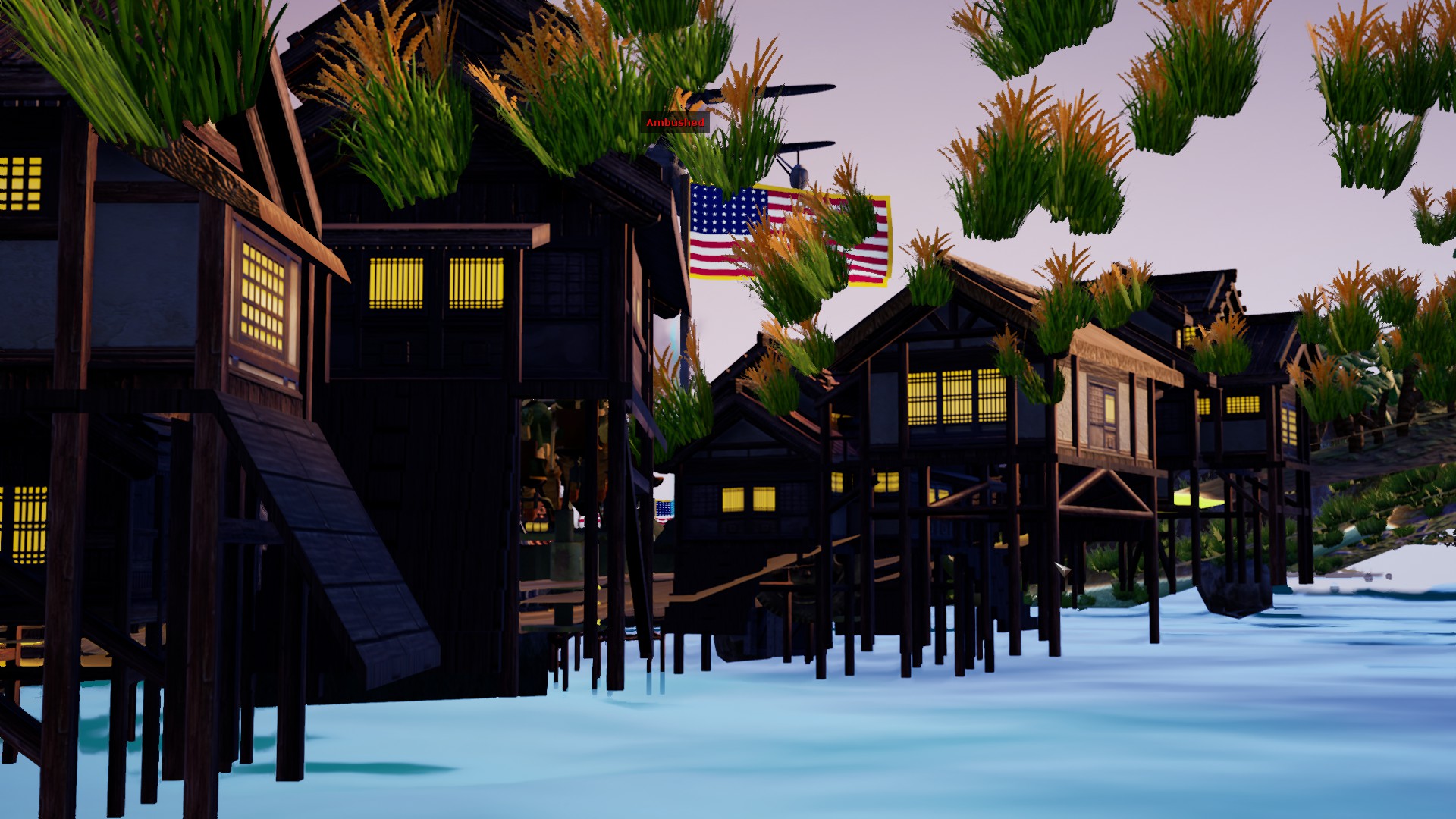
The major problem with this stop-everything zoom-in is that,
A) It removes all context so you don’t know what’s going on even if the units themselves aren’t obscured like in the above image.
B) It violently whips the camera around, so I hope you don’t get motion sick easily.
C) It’s utterly pointless and shows off how bad the models are more than how pretty they are.
D) It makes everything take about four or five times longer than it already did.
E) It makes it even more difficult to see the damage notifications which are the only things that matter in an exchange of gunfire.
Overall, it’s just a continuing trend of Strategic Mind trying to wow you with “production values” it reeaaally doesn’t actually have instead of focusing upon what it actually does well as a game.
Another persistent minor, but annoying bug is that the “strategic phase” between missions where you buy new units and such take place in your admiral’s office, but there’s a bug that makes the room dark basically all the time. I don’t know what causes it, but once it happens, it never goes away, and even the “new game” section has the lights off.
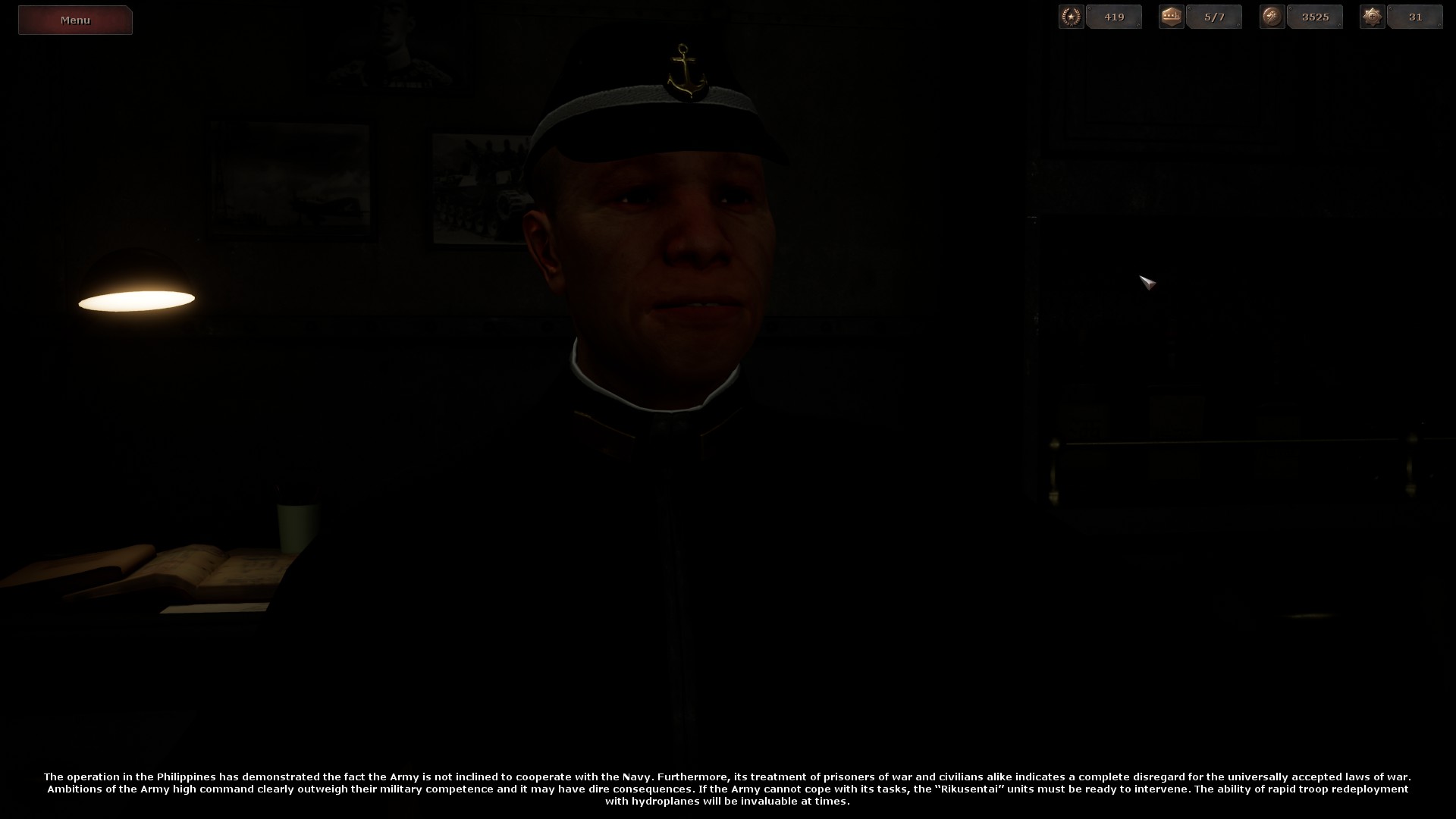
Beyond that, however, I did encounter multiple freezes and crashes to desktop. I can’t find a consistent pattern, but they always happened after clicking on a unit or a place to move a unit, and seem to occur most frequently during anything involving transport ships or the deployment phase adding or removing units from the board. The crashes simply dropped me back to desktop and launched the Unreal Engine error reporter, which isn’t terribly bad, especially since the game autosaves at the start of turns. The freezes, however, would lock my computer up for anything from two minutes to up to ten minutes with that really annoying one repeated note thing going on before the game would then just suddenly keep playing like nothing had happened at all. Basically, when it happens, I hope you didn’t have the volume up too loud and just go read a book for ten minutes until it gets better. The devs are aware of problems and trying to fix it, so hopefully, it will get patched, however. It’s a big annoyance, but not anything that totally took me out of the game because it did at least happen relatively rarely enough that I wasn’t getting completely fed up with it. (About one freeze or crash every 5 hours.)
Savescumming or Clairvoyance
Although this is a problem that most of the Panzer General-descended strategy games have, it’s something that really demands talking about, regardless: This is a game that overtly rewards, if not demands savescumming.
Savescumming can take place on the relatively minute level, like reloading when you’re trying to bombard a bunker with a destroyer and reloading any time you deal 0 damage. Unlike most games, in Strategic Mind, if you load a save on the same map, it’s practically instantaneous. This can be the difference between a target being destroyed or surviving to escape, and so there’s some pressure to savescum this more minor, yet dubious way, but that’s not the real problem.
The real problem is that the game is filled with unforeseeable events or enemies that teleport in. Coral Sea is a good example – they tell you that there’s a carrier fleet out there, but search all you want, you won’t find it until you hit “next turn” and it teleports just a few hexes away from you, launching planes into your face. You had to curl up into a defensive ball and protect your bombers to weather the storm, but there’s no real warning that’s what’s happening. On that turn the first time, I sent out my dive bombers to sink the remaining destroyers, but then they were blown out of the sky by zero fighters that didn’t exist on my turn. I had to reload a save from a turn before and land the bombers and deal with the destroyers entirely by surface ship fire while sending up fighters to protect against an incoming wave of planes that I didn’t even get a warning about until after the destroyers were sunk.
This isn’t as bad as some games have it – some of Panzer Corps’s DLC in particular is notorious for having ambush events that would take outright clairvoyance to avoid needing to reload several levels back to deal with.
With its strong incentivization of “perfect missions” where you get rewarded with more units and powers for completing missions without taking losses that let you better win further missions without taking losses creating a snowballing effect, there’s an overwhelming push in this game to just play through, reload, and try again to get an “Absolute Victory”. This winds up undermining the strategy in this turn-based strategy game when the only way to play correctly is to know in advance what moves the enemy makes not through rational thought and foresight, but outright watching the enemy move. It pays to simply hit “next turn” a couple times in a row without moving to see what the enemy is going to do or what events are about to trigger if you do nothing after you get to a new turn since it’s much faster to just see it play out than find out you didn’t prepare for the surprise fleet that teleports right on top of where you are.
Even without teleporting enemies, scripting of enemy actions makes reloading to preemptively react to event scripts you only understand after seeing them happen once the only way to get good scores for missions. Pearl Harbor, for example, tells you in the briefing to sink the battleships, blow up the enemy planes on the airfields before they take off, destroy the radar stations, blow up the oil depots, blow up the power generators, and blow up the shipyard in any order you choose. Except you should choose to prioritize the AA guns that will make your life utterly miserable if you don’t destroy them in the first two turns, because those and the one destroyer that is operative are the only real threats to your aircraft. I don’t know what the radar stations do if you don’t blow them up, but the aircraft seem to not take off until you’ve had plenty of time to destroy everything else on the island of note besides the battleships that will never respond to you. While you can probably predict destroying AA guns is important, you wouldn’t necessarily expect that it’s more important than taking out the aircraft, and so you have to restart to figure out that proper order of targets if you want the perfect score. And you want the perfect score because it lets you get promoted after just the first mission instead of having to wait two missions to get more command points to use special abilities with…
Basically, the combination of easy reloading, demands for perfect runs, and unforeseeable situations mean the game becomes much more reloading-based trial-and-error than actual strategy, and that really hurts its core premise. This is exacerbated by the utter lack of randomized content, user-created content, or multiplayer options, since those are the things that prevent such savescummy tactics from being the preferred method of dealing with the game.
Difficulty Options
One thing I have to note for being rather different and a good idea is the custom difficulty option.
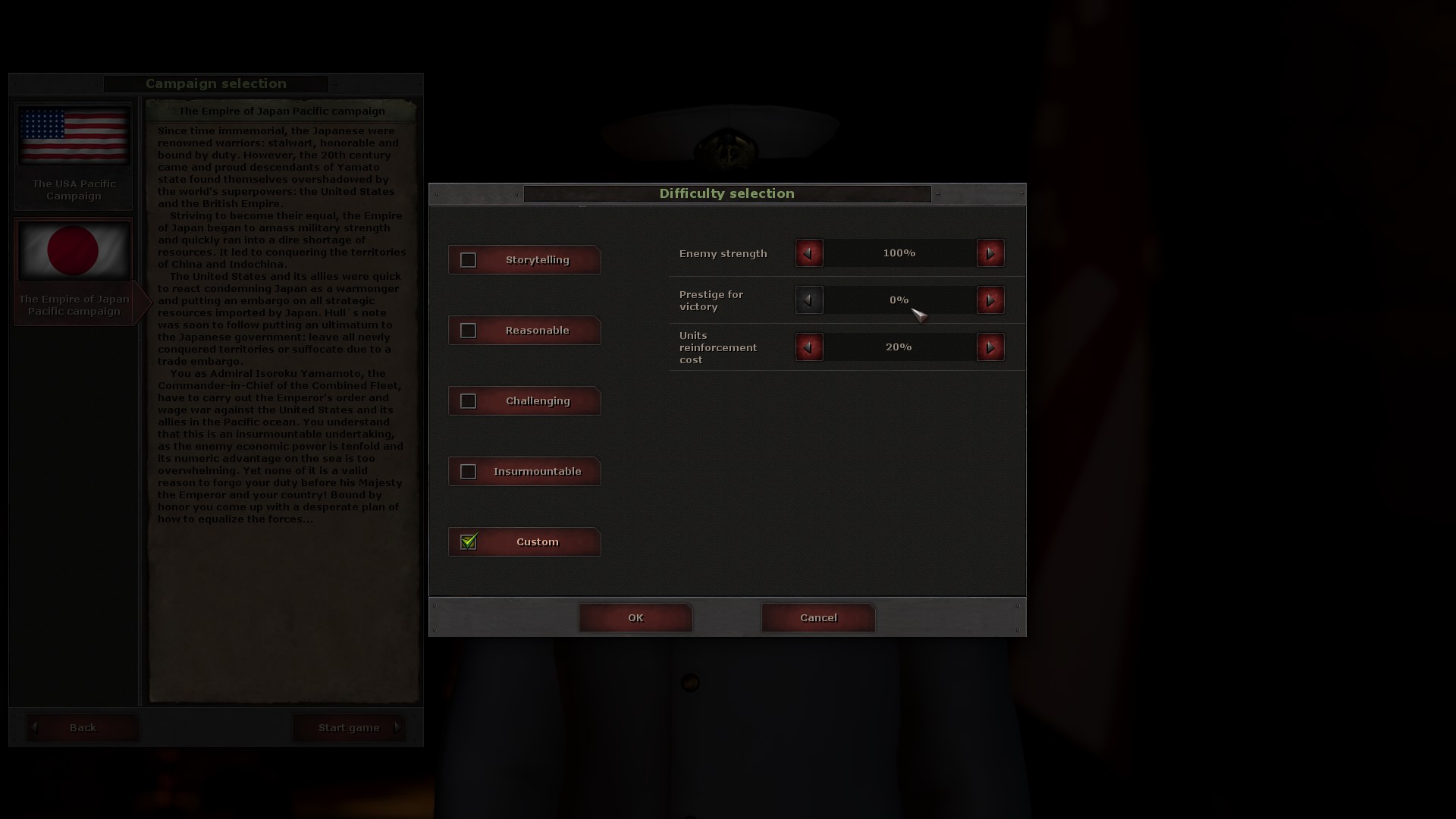
The “Enemy Strength” option directly cuts enemy HP and nothing else. Even with an enemy strength of 20%, your units have normal HP, enemies deal normal damage to you, and have the same AI, but they just have much less HP, so it’s a somewhat odd measure of difficulty that actually doesn’t help if you are attacked by your unit’s weaknesses.
“Prestige for Victory” is what’s particularly notable, as it directly multiplies your prestige income for completing mission objectives, and you can actually set this down to 0%, effectively crippling your prestige income. This means you basically have to beat the game without buying any new core units or significantly upgrading existing ones, so any damage to core units is even more punished than before.
“Units Reinforcement Cost” is essentially more of the same as above – normally, between missions, you restore the HP (reinforce to replace losses) of your units for 20% of the base cost of the unit, although you can repair them mid-mission for 50% of the base cost. This difficulty option lets you crank up the prestige costs of repairing units to the point where you might as well buy new ones for the repair costs you’re paying, and directly punishes allowing expensive upgraded units to fight on the front lines.
It’s worth mentioning that this game has no map editor or multiplayer like much of its competition, so you’re stuck in single-player. Trying to get higher ranked victories or trying to play with more challenging difficulties is the only replayability offered.
The Voiceacting…
It’s OK, Starni Games, nobody expects you to be like Blizzard and have dozens of voiced lines for every unit type with all sorts of jokes and references to Aliens for the space marines or anything, so please, please stop trying. Starni Games is a small indie developer apparently from Russia (at least, anything I can find about the company is in Cyrillic) whose only previous games are Panzer Strategy and some 2d multiplayer space ship game that is only in Russian. It therefore simply does emphatically NOT have the budget to do the kinds of graphically spectacular cutscenes or hire voice actors that are… well, in any way up for the task.
At the second layer of the feverish nightmare that is the production values of this game, just after the pointlessly detailed graphics that they force zoom-ins to make you see, is the voice acting for the game’s units. Unlike the cutscenes (oh God, the cutscenes…) I’m still counting this against the game, because it is actual gameplay.
Click on a unit, and that unit will spout out a random one-liner about itself, and it will spit out another one when told to move or to attack or maybe a couple other things. The problem is, this is a halfway-decently translated indie Russian game that couldn’t afford more than about three people to do all the voices, and so they have to do the worst accents to try to hide that fact. Making this worse, these voice actors forgot what accents were supposed to go with what units, so they rapidly change accents between clicks. In fact, they seem not to have been given more than one take on some of these, because the actor starts one line with a deep accent then starts laughing in the middle of the line and forgets to keep the accent up by the end of the line. (Begin the slowclap.)
Also in that “chasing the Blizzard game” vein, what they say is supposed to be “funny”, but they can’t manage to get past penis jokes. Need I remind you that this is The Darkest Hour of Humanity, you’re trying to hold back the seemingly inexorable charge of an implacable foe in the most destructive war man has ever inflicted upon himself, and we’re treated to American fighter pilots screaming “Take it!… Take it, bitch… UNNNNNH!”
Also worth mentioning is that even when they are consistent, the accents make no sense for the units in question. American battleships spout off “I have big guns… IF you know what I mean” in a French accent, while Japanese battleships quip, “A battleship is like a fugu fish… deadly… but delicious” in an American accent. (Did he just suggest he was licking his battleship?) The American bombers sound like they dragged out the most drunk, sleepy, elderly and stereotypical British pub crawler and had him quote lines about statistics in a dreary tone. The Japanese bombers speak in the most cheerful (American-accented) tones about how they enjoy burning people to death.
This applies to the allegedly historical figures, as well. Admiral Yamamoto sounds like a goofy teenaged nerd. Admiral Nimitz sounds like he’s speaking his lines while trying to impersonate what John Wayne would have sounded like trying to smoke 12 packs a day.
In fact, the only Japanese voice that even sounds like it’s trying to sound like a Japanese person is the submarine (whose lines include spouting “silent AND deadly” because of course it’s a fart joke) which sounds almost exactly like the famously racist yellowface Mickey Rooney caricature from Breakfast at Tiffany’s.
But hey, that’s just cringe-inducing and grating. It’s not staring directly into the abyss like…
The Cutscenes…
OK, I’m going to give the game in general a pass on the cutscenes because they’re not really gameplay related, and you can enjoy the game while skipping the cutscenes.
In fact, you can definitely enjoy the game more because the cutscenes are here, but not for the reason that the developer intended. These things are a straight-up train wreck of epic proportions. You have to see them. They’re legitimately so bad they’re hilarious.
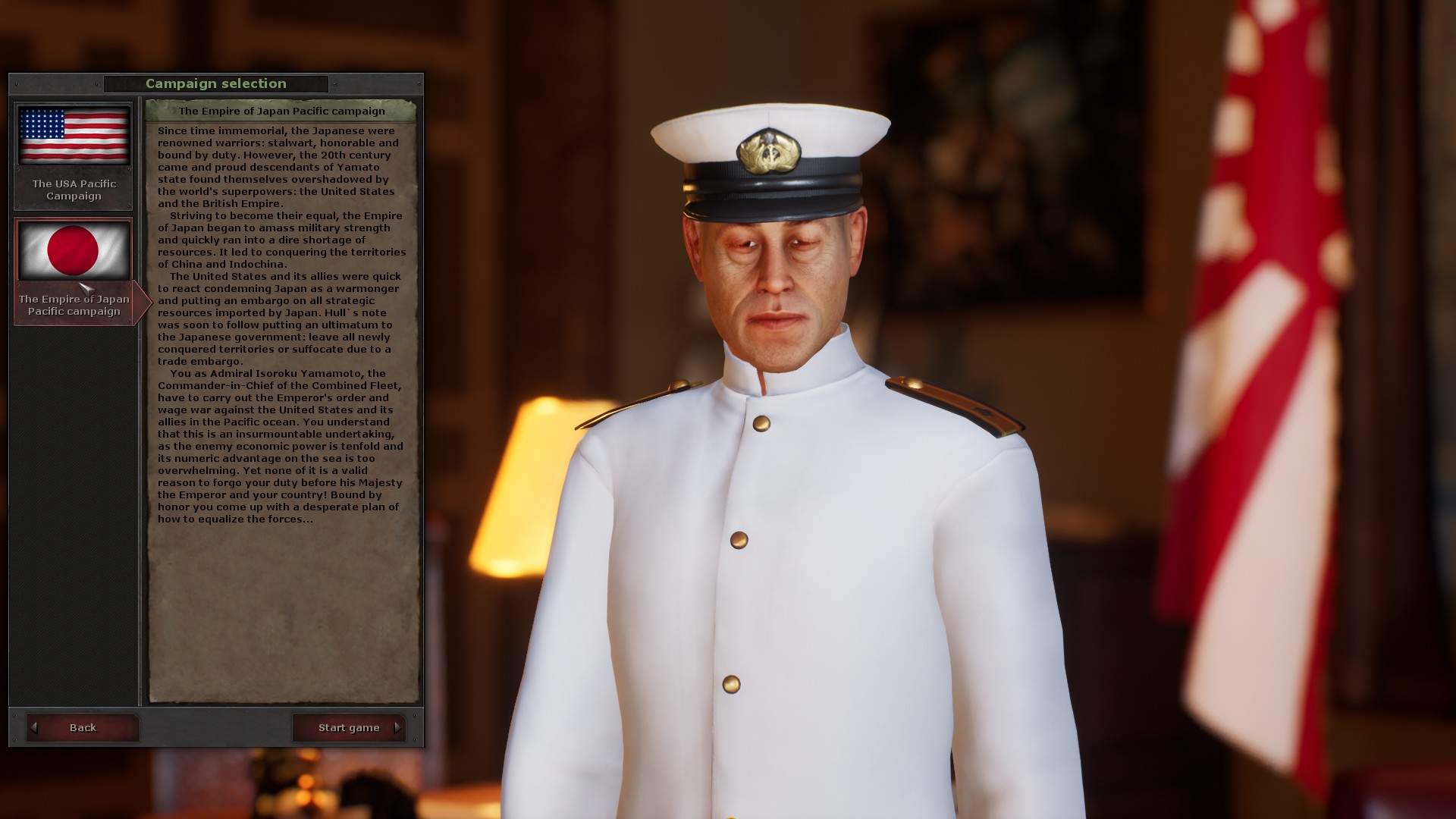
What makes them all the more bewildering is that they’re so utterly unnecessary. This is a turn-based, hex-based strategy game, it does not need 3d models at all, much less cutscenes that “re-enact” ludicrously historically inaccurate scenes to give World War 2 context. For comparison, consider that most of this game’s competition uses 2d models for everything, their briefings are text with actual (often monochrome) pictures of the real person, and games like Order of Battle create historical context by showing actual newspaper headlines and images from that time, such as Manilla being abandoned by US troops and being declared a “free city” so that the Japanese wouldn’t bomb the city or kill its civilians. (You not only have to kill US troops to take Manilla in Strategic Mind, you have to race the Army to do it as a secondary objective.)
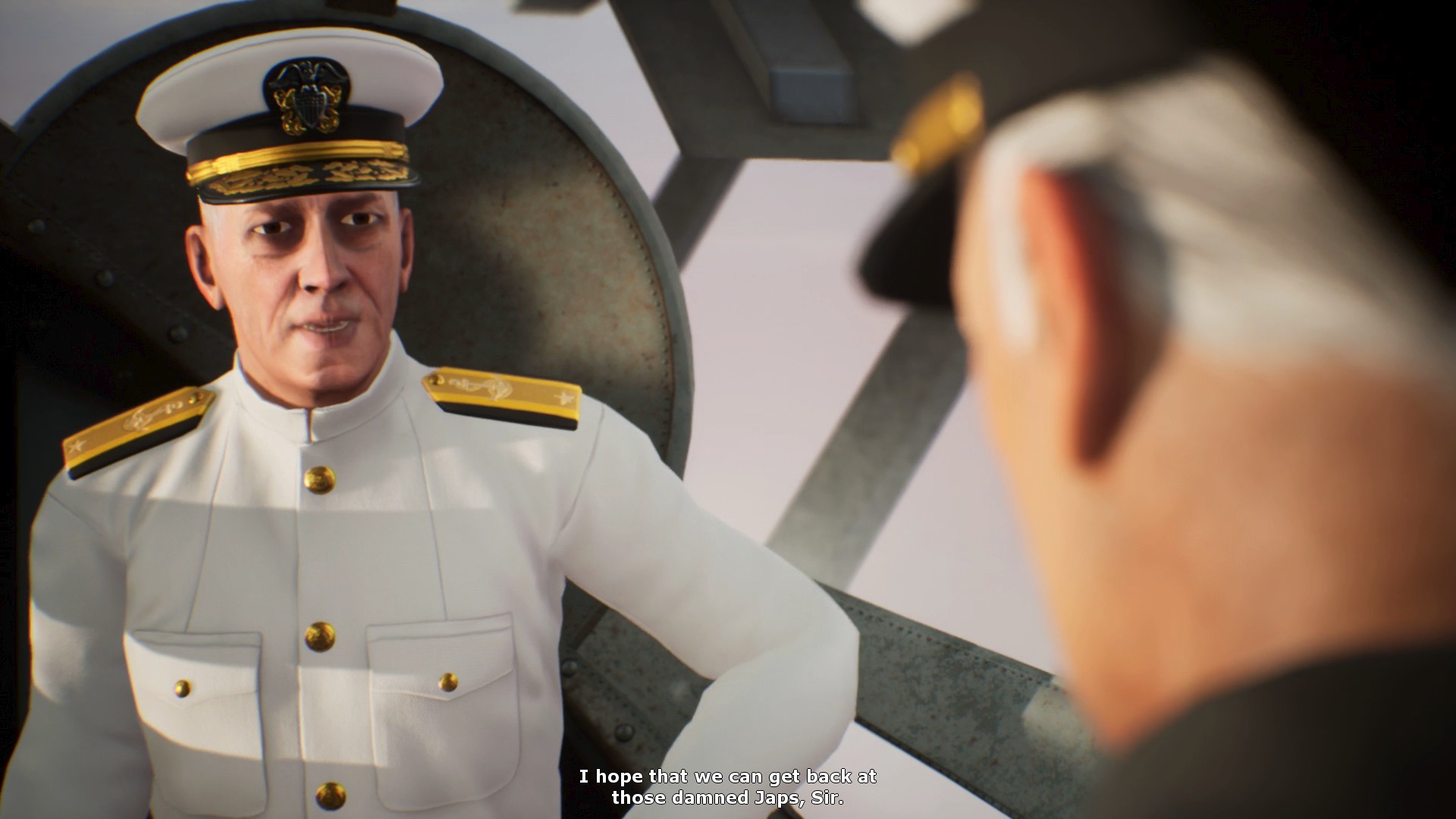
It honestly kind of feels like this whole thing was added because the developer had some guys who could make this great strategy game, but they also had hired some people who do model work and cutscenes, and they needed to find something for them to do, so, well, let’s just let them rewrite the history of World War 2 to make this game’s order of missions somehow be more “cinematic”, no matter how nonsensical…

While it’s impossible to demonstrate with screenshots alone, I cannot overstate how hilariously awful every part of these cutscenes are. The character models look sickly and wooden.
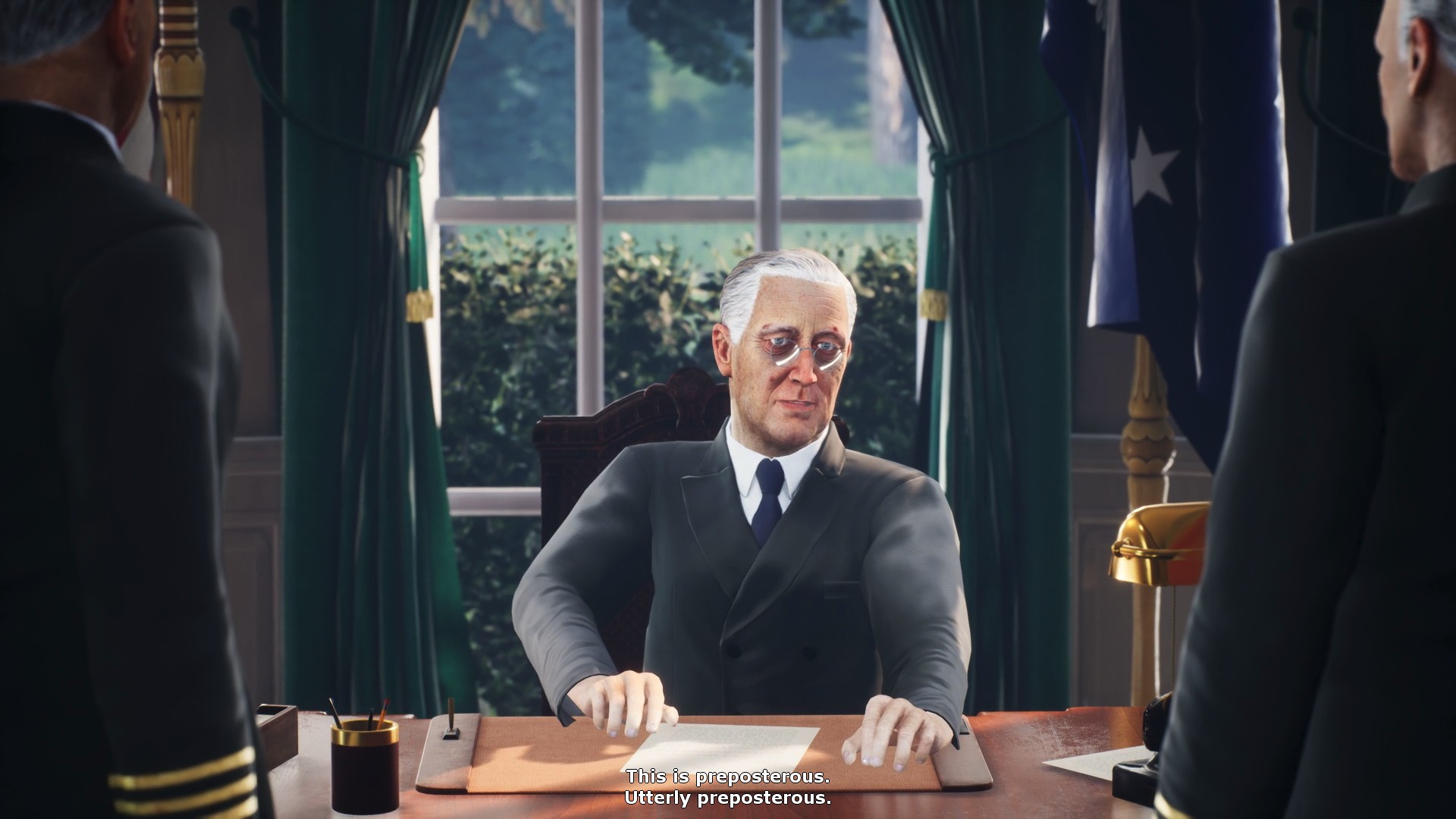
And speaking of “wooden”, the flapping-jaw speech, the incredibly stiff movement animations, the glassy-eyed stares, the utterly monotone voiced line delivery (seriously, FDR sounds like they just had Microsoft Sam read his lines) all make you feel like you’re watching a parody of a puppet show, like Team America. The utterly boneless flapping of the jaw especially reminds me of a Muppet character.
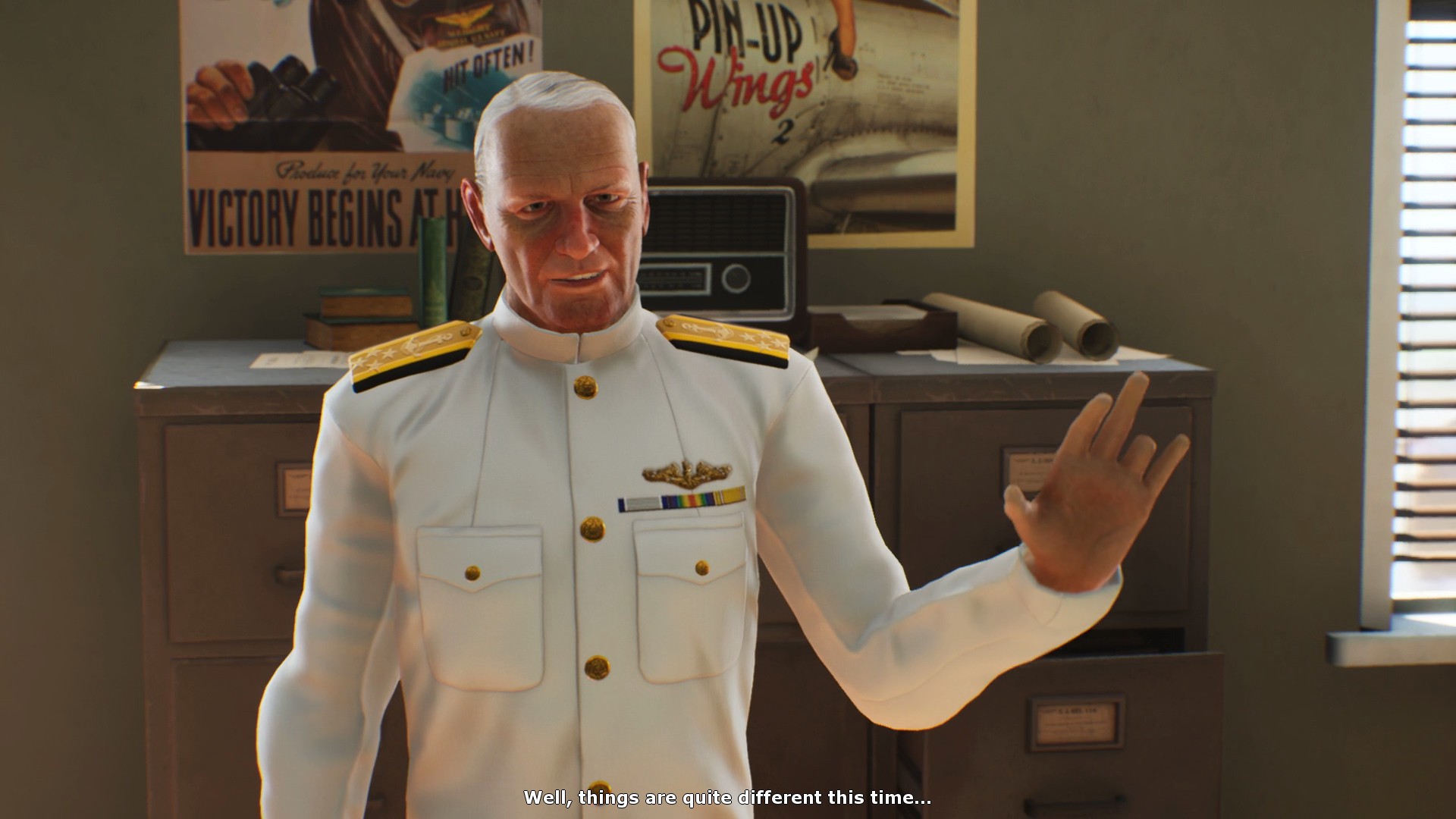
It’s all like how an alien race might try to reconstruct how earthlings behave…
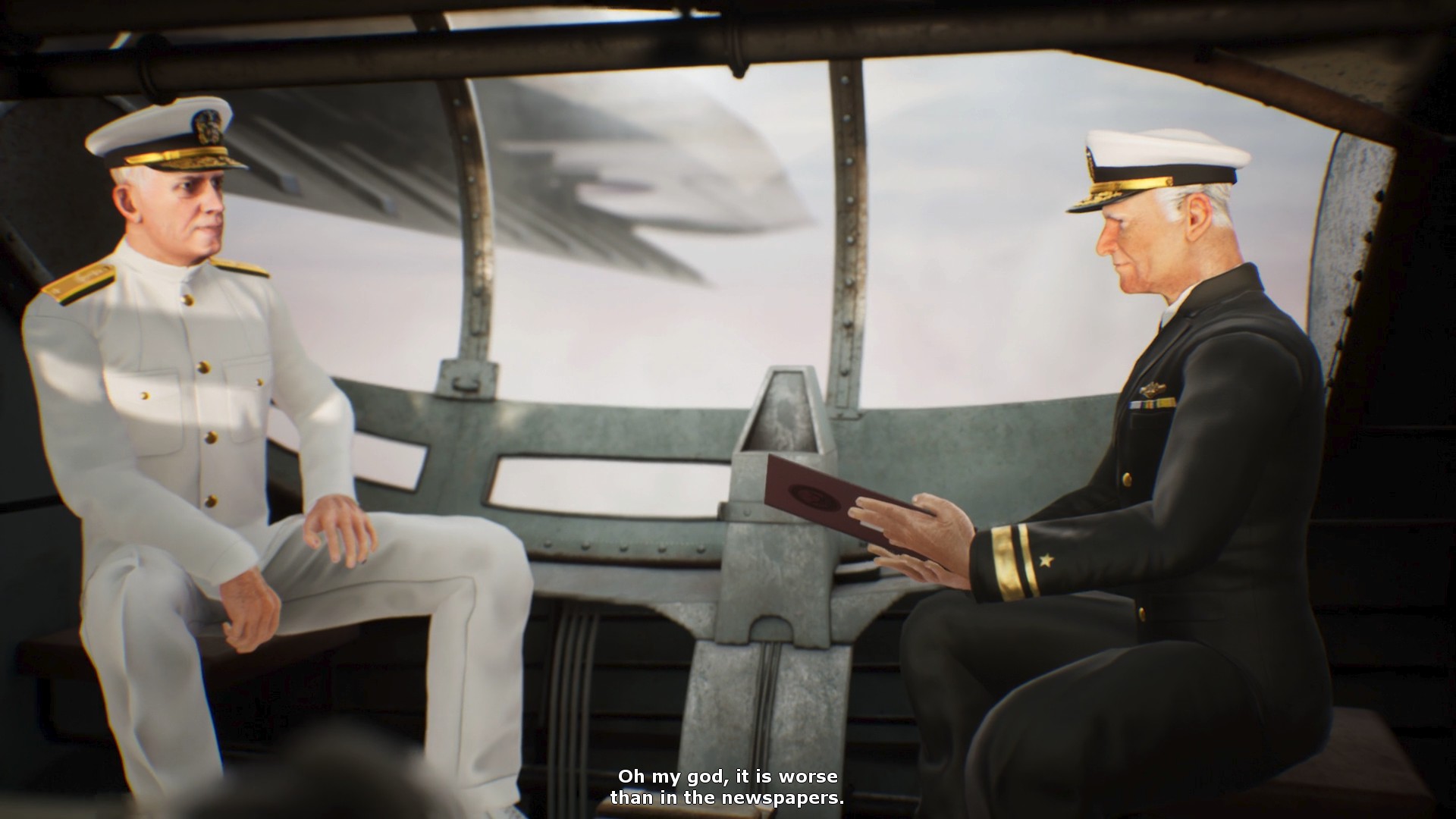
Not to mention, Prime Minister Tojo is shown almost looking like a racist caricature from a propaganda poster during the war. (In fact, Yamamoto seems rather buck-toothed, and I’d say it looks kind of racist for all the Japanese characters, if not for the fact that Nimitz also looks like a bucktoothed simpleton and his aide looks even more like a muppet than anyone else.)
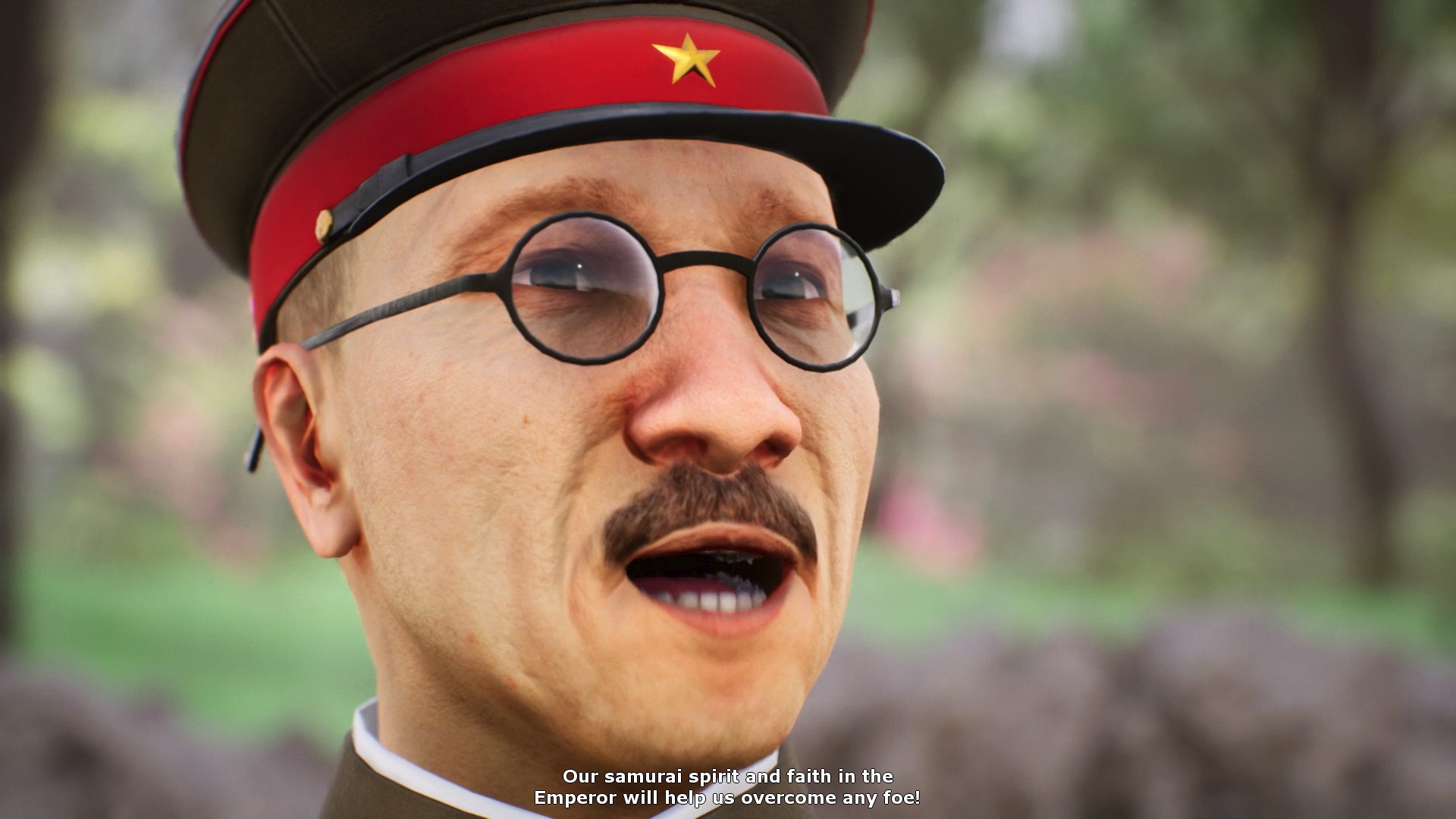
Speaking of unnecessary, however, all of this is rendered in-engine for no good reason. This is why the game has an unusually huge download size. The actual game itself tends to run just fine, but the cutscenes are severely unoptimized and can cause my computer to chug, especially the ones that aren’t two guys in a small room, like the actual attack on Pearl Harbor, which actually starts to stutter and lag on my computer. Even the main menu plays inexplicably not pre-rendered highly detailed scenes from their imagined version of the war that makes the main menu take up more computer resources than the game itself.
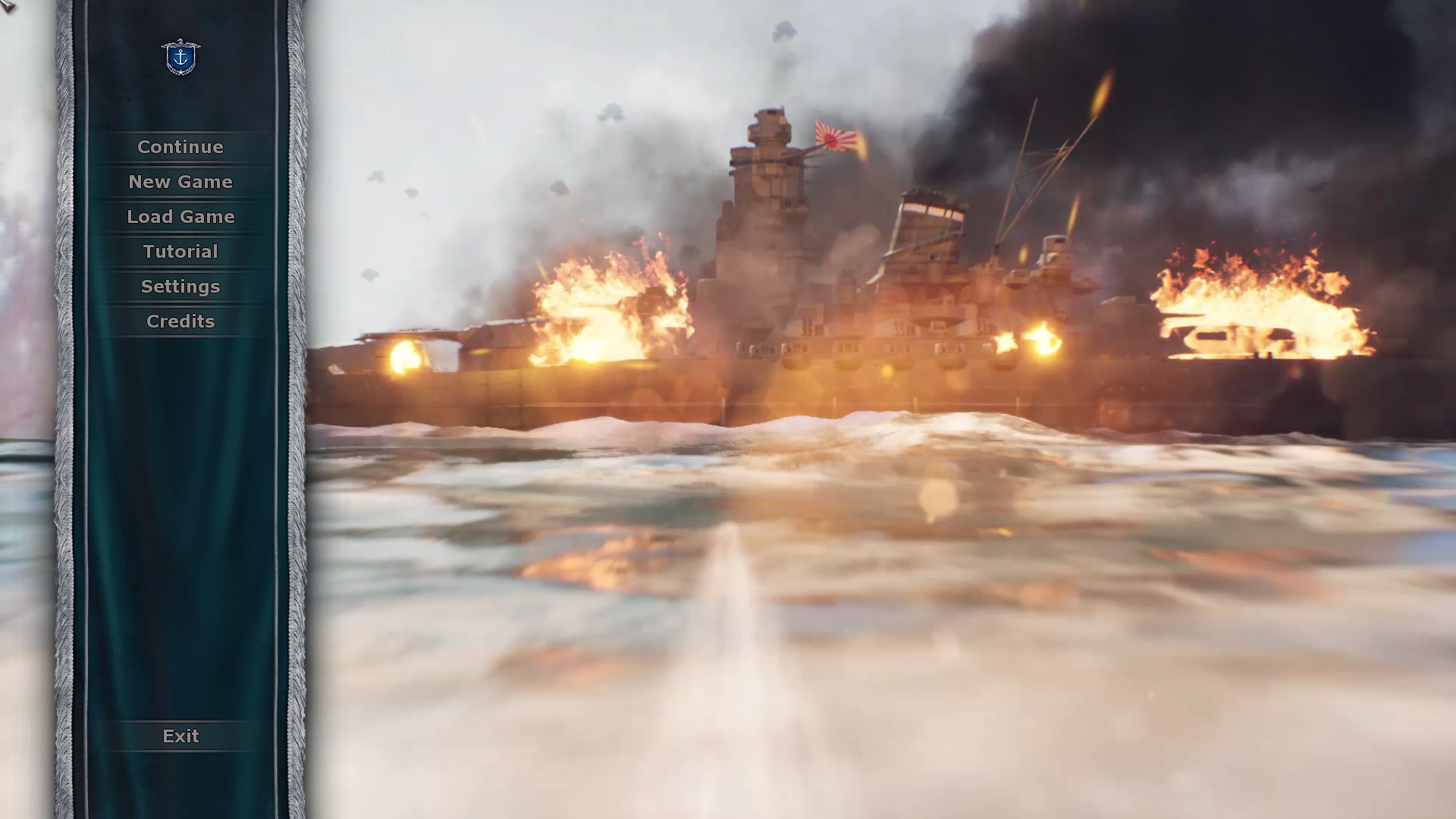
Historical Revisionism and Character Assassination
OK, I realize that some of you “just talk about the gameplay” types are going to get mad about this section, so I put it at the end and you can just skip to the verdict if it makes you mad. I’m not rating the game any lower for this, but…
I just can’t ignore how a game that wants to set itself in World War 2 so drastically rewrites history for inane or outright spurious reasons. This runs the gamut from the “they’re overlooking war crimes” stuff that people tend to most vehemently not want to hear about to just outright rewriting how characters behaved or what they believed.
A major example is the cutscene at the end of the Raid on Pearl Harbor. While Yamamoto planned the attack, Admiral Nagumo was the man in charge of the actual carrier fleet that carried the plan out. In-game, however, you (as Yamamoto) micromanage the every movement of every plane while having a situational awareness that no admiral in the mid-20th century could even dream of having, so Nagumo largely is just a guy that speaks a few lines when you complete a secondary objective. In those lines, he talks about what a “waste of time” it is to blow up the American oil reserves while Yamamoto corrects him saying it’s months of fuel supply the Americans would use to counterstrike their forces. At the end of the mission, Yamamoto orders Admiral Nagumo to attack Midway island, while Nagumo refuses because it’s “beneath him” and it’s “as if a Sumo wrestler has just become a champion, and he is challenged in the street”. (The game is absolutely full of these kinds of “folksy sayings” that make it perfectly clear nobody who knows the slightest thing about Japan had anything to do with the script.) Hence, Nagumo directly defies a direct order from a superior officer while telling his men to pass along the insults he was saying to said superior officer while he was at it.
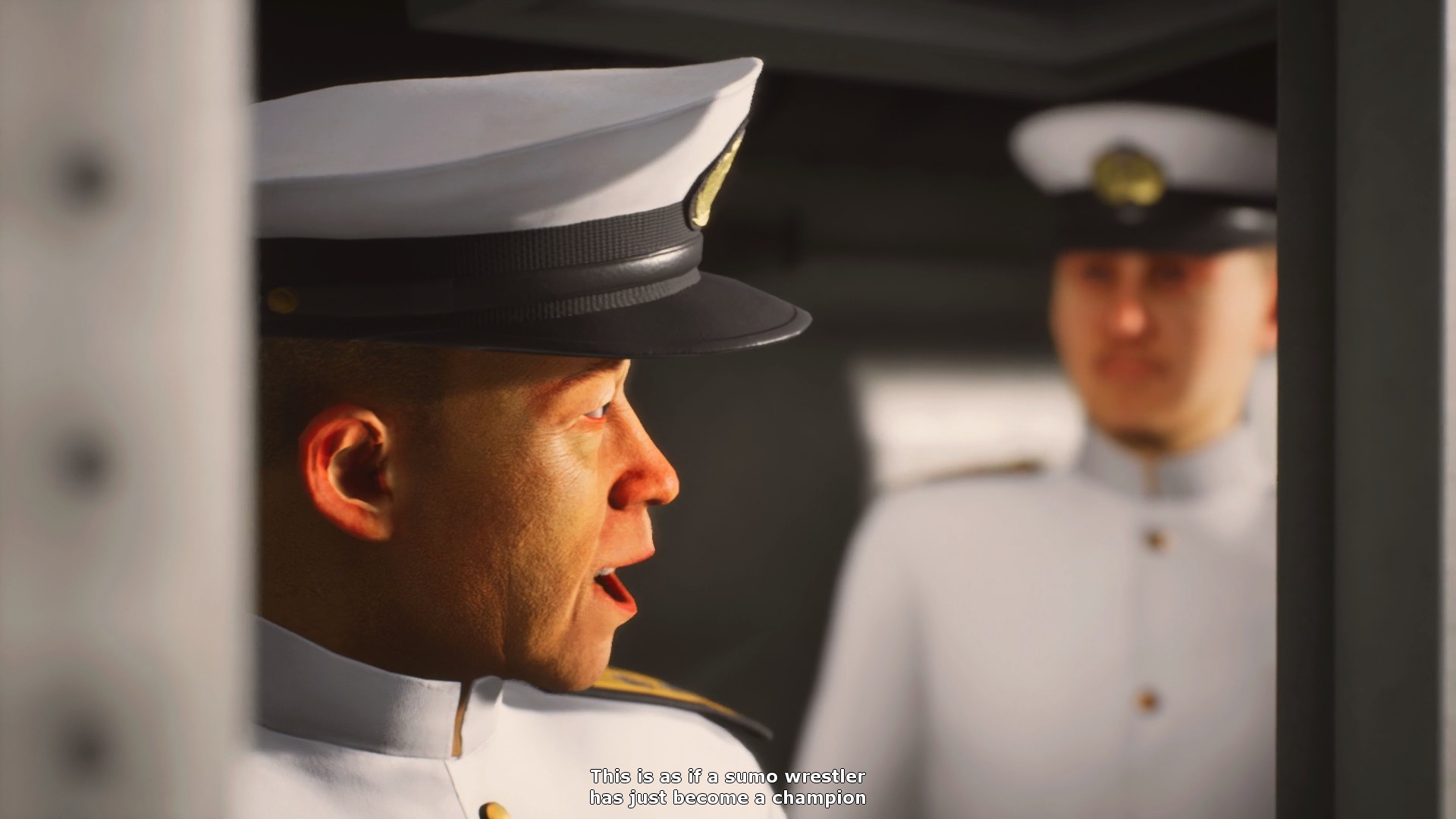
I had trouble believing this could have actually happened in real life, so I tried looking it up, but it was kind of hard to find any references to it because it definitely never happened.
Instead, what this seems to be a reference to was that Nagumo was ordered to carry out further strikes against Pearl Harbor in order to blow up the fuel depots that were a secondary mission in the game. Nagumo refused to keep up the assault and withdrew from Pearl Harbor after damaging several of the battleships because he had been given bad intelligence that led him to believe the American air units (which had actually been almost completely destroyed) were still in good condition and may have the ability to retaliate, and hence he didn’t carry out further waves of attacks since he believed the fuel depots weren’t worth the risk to his men when he’d carried out what he saw was his primary objective already. The problem for the game’s developers is that you can (and I did) blow those fuel depots up, so they decided they would change history a little to make there be something where Nagumo refused an order, but it was a new order that was beyond the scope of Pearl Harbor.
So what did they pick? Yamamoto orders Nagumo to invade Midway, you know, just as a casual last-minute thing tacked onto the end of his meticulously-planned-over-months operations to assault Midway purely by air with no landing forces ever prepared. Something that makes absolutely no sense in context, because Midway may be the location of a major battle, but it had basically no strategic value to either side. It was a landing strip on a tiny lump of sand peaking out of the ocean only useful for refueling search planes.
Why, then, does Admiral Yamamoto have this obsession with Midway from the very start of the game? Well, you see, when a good writer wants to show that a character is a Sherlock Holmes-level genius, they’ll put clues into a story, and then have that character make a deduction based upon the same clues that the audience has. It makes the audience feel they could have made the same deduction (and some of them can feel smart for actually making that deduction), and therefore they understand how that character is a genius by being able to follow their logic after it’s explained to them. Hack writers, however, either are too insecure to let anyone in on their “genius” character’s thought process, so they only declare conclusions or else those writers are honestly not smart enough to understand how smart people think, so they just make the “smart” characters seem “smart” by making them clairvoyantly know what the author already has planned. (“Daenerys is going to betray us, even though we have every reason to trust her by what’s happened in the plot so far and the only reason I give is because she’s pretty, and I apparently hate women who are prettier than me!”) By contrast, “dumb” characters are represented by making them be insufferable jerks who hate the Marty Stu main character for no reason and aren’t allowed to read ahead in the script.
So, basically, they’ve taken Nagumo not following all his orders due to a poor judgement call based upon bad information and a good faith desire to preserve the lives of his men against an unknown enemy, and turned it into a military officer flagrantly ignoring orders while insulting his superior officer for absolutely no reason other than sheer arrogance. Yeah, hypothetically this “solves the problem” of the thing Nagumo was ordered to to possibly being done by the player, but don’t you see how this kind of changes how the character of Nagumo is portrayed?
The cutscenes are full of this kind of nonsense! Basically every single thing they show cuts out critical context or outright rewrites history to “make a better story”, mostly in service of trying to make the playable characters, Nimitz and Yamamoto look like “genius” Marty Stus while everyone around them is made to look like a babbling baboon in a military uniform.
Why is this so annoying? Well, it’s not just some fictional story like a Warhammer 40K game where they make characters you liked in other fiction look stupid all of a sudden, these are real people they’re slandering for no good reason but to make their crappy WW2 fanfic. What makes it worse is that there’s nothing particularly signposting just how badly they’re getting the history wrong. I mean, I’m not a historian – I’d have probably punched straight through the monitor if I were truly invested in knowing about WW2 with this story – I had to actively look up what it was that the Nagumo refusing orders thing was referencing. Most players don’t bother, and just run with this fiction as though it were fact.
What’s that? The Japanese committed war crimes during World War 2? Nah, all the war crimes in Strategic Mind exist just so Yamamoto himself can personally stop them. And all the attempts at them were personally caused by this one guy from the army who looks like he’s about to buy Han Solo frozen in carbonite:
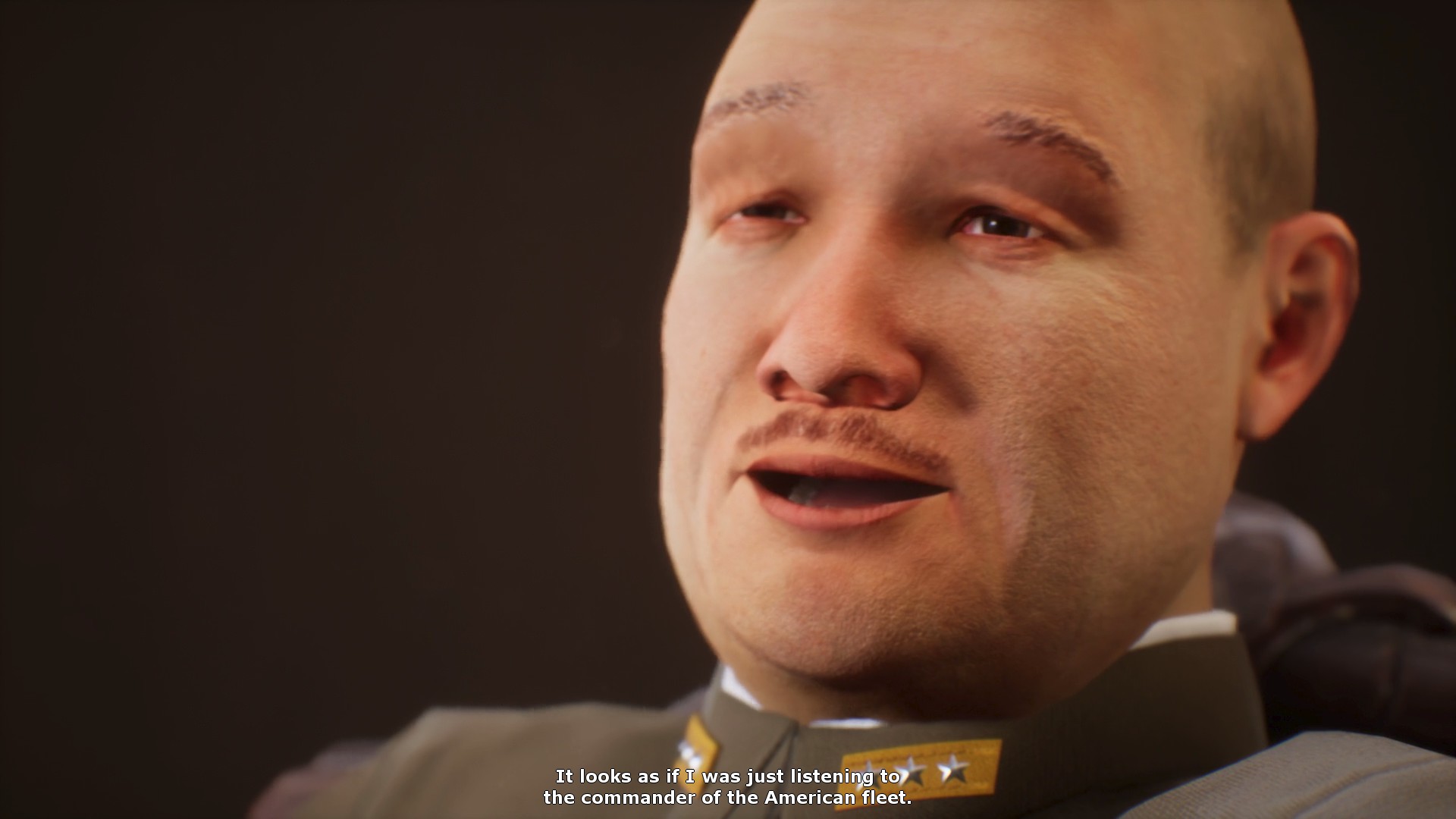
Again, this is a real person, and even if he definitely may have deserved real criticism for really being an nationalist leader who pushed for reckless expansionism without regards for the fact that they couldn’t possibly defeat all the enemies they were making, that’s not the criticism that’s really leveled at him by this game. The game just tries to make him say mean things to our perfect, sparkly husbando Yamamoto.
The Japanese intro cutscene starts by having Tojo complain that the United States is calling Japan a warmonger just because he’s been declaring a bunch of wars and conquering a massive chunk of Asia with no signs of stopping (which seems like a good reason to call someone a warmonger), and that the best solution to this insult is to declare war on the US. (That’ll show ’em who’s a warmonger!) Basically, the game ignores all the political pressures and factions within Japan that led it to aggressive expansionism, and makes it all Tojo’s fault for being some delusional moron. It comes as a surprise to him later on that the oil embargo placed by the United States is actually cutting off all the oil in the nation that does not domestically produce oil, and he has to order Yamamoto to seize oil-rich islands (of which the Philippines apparently didn’t count, because that’s why the Japanese invaded the Philippines first).
Yamamoto is rightly portrayed as being opposed to war with the United States because he knew the odds were too stacked against them. He famously said he would rampage like a tiger for six months through the Pacific, and for six months he was largely undefeated before Midway turned the tides and Japan inexorably lost, but he wasn’t an infallible clairvoyant. At the time of the loss at Midway, Yamamoto was preparing to send his battleships in to fight the American fleet he was sure was coming and pop the champagne when he got the word that all his carriers had been destroyed. Yamamoto was convinced that western powers could be brought to negotiate by a “Kantai Kessen”, or decisive fleet battle the way that a crumbling Tsarist Russian empire had surrendered after a naval loss proved that war with Japan was too costly for an empire about to collapse into civil war with the bolsheviks. He thought if there were some big battle where America lost some battleships in a straight fight, America would surrender when it very definitely was never going to do that, especially when it was capable of cranking out new warships faster than the Japanese could ever sink them.
The story as a whole goes out of its way to rewrite history to portray it as the story of how destiny itself conspired to make these two GREAT MEN who were, presumably STRATEGIC MINDS were in a clash of destinies, and everyone else was just the backstory to their greatness. It wants to revel in the supposed Japanese honor of this guy to the point that it invents this ludicrous scene of Yamamoto saying goodbye to his geisha while playing shougi before going to war.
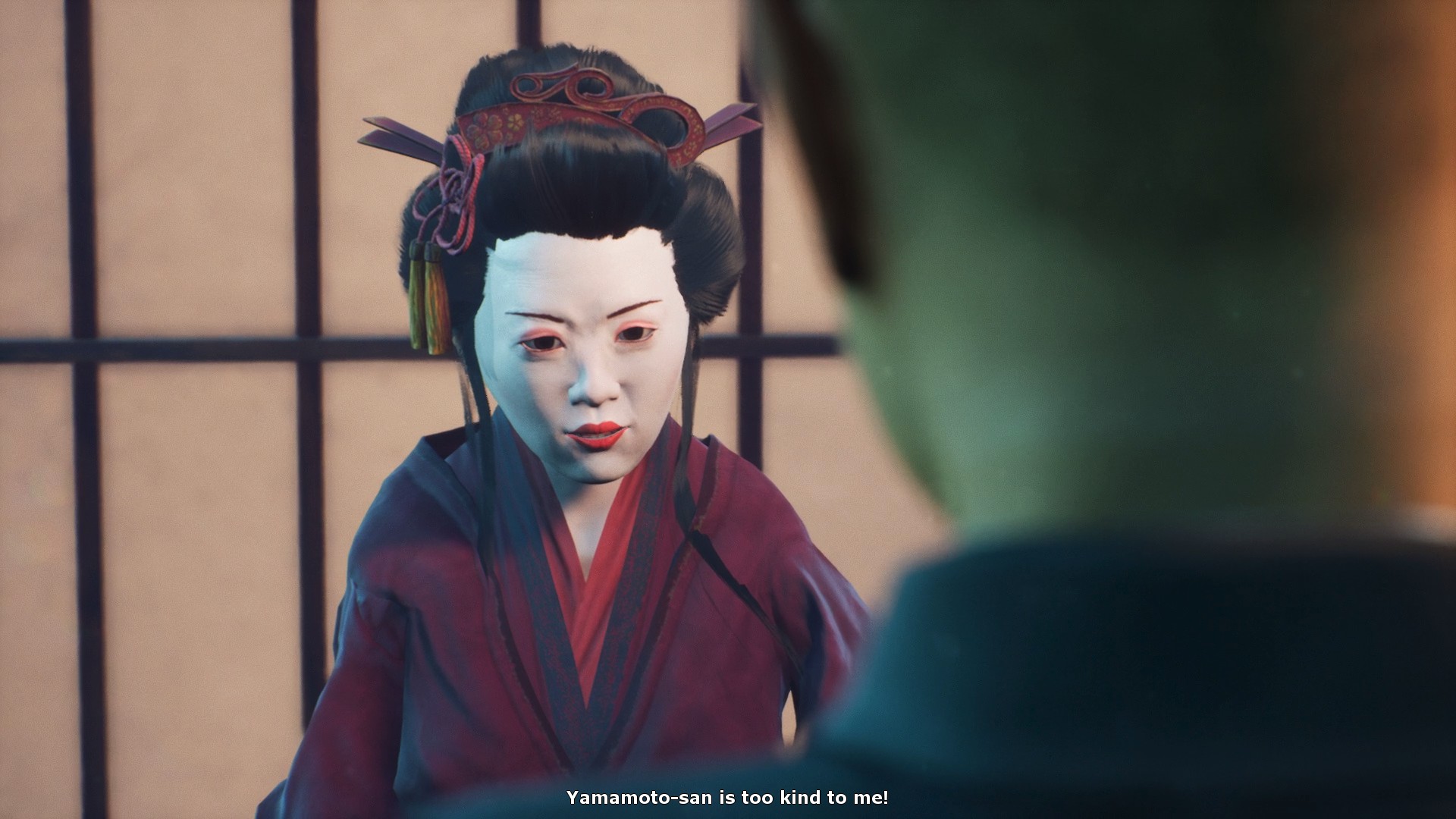
THIS MAN HAD A WIFE AND TWO KIDS! But no, we definitely have to show him going to some decrepit shack from the 15th century to say goodbye to his shougi-playing geisha instead of his actual family, because families are too relatable, we have to show how Japanese he is.
Naturally, while I’ve focused upon the Japanese side for how utterly ridiculous some of the points are, this applies full well to the completely bonkers American campaign fictional story as well, although in the clumsy attempts to make Nimitz-sempai notice them, the writers accidentally frequently wind up making Nimitz look like as much of a stone-cold moron as everyone else.
Because the first battle on the American campaign is the Battle of Coral Sea (they’re skipping straight to when America starts to stop losing, if not win battles so as to avoid rewriting history… so far as the battles go, although God knows why they’re worried about that at this point), they decide to have an in-story excuse for why Nimitz apparently does nothing for five and half months while America loses basically every battle they get engaged in. And so the excuse for why the man who never loses a battle lost every battle for five months running, including the Battle of Savo Island, “The Worst Defeat in US Naval History” is because… he planned to lose them all! Ha HA! He’s crazy like a fox that’s been eating lead paint chips and hallucinating while whimpering softly as it drools to death in the corner!
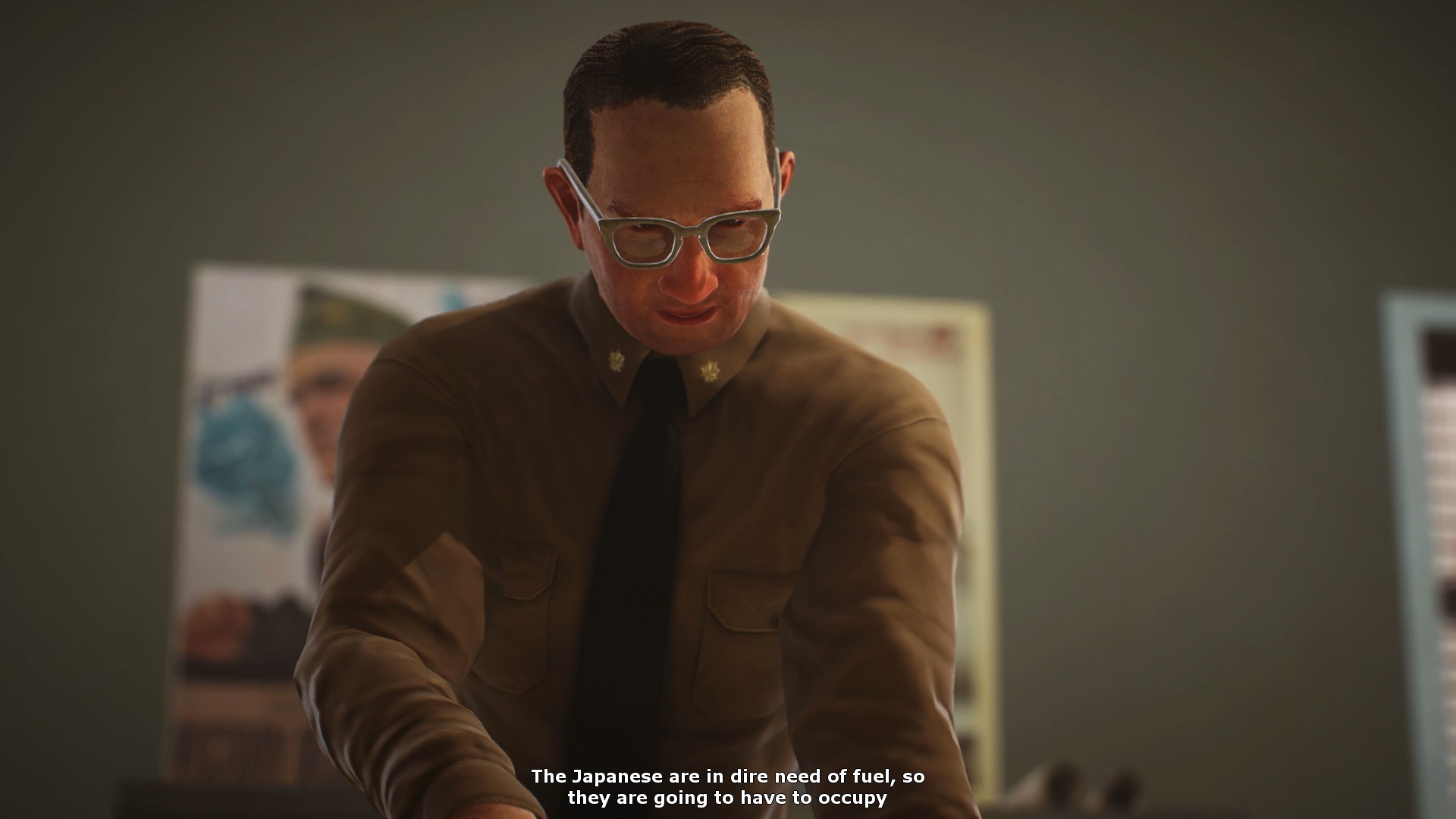
Putting aside the utter asinine nature of “I PLANNED to lose all those battles”, the time that he chose to actually take control of the war and do something to stop the Japanese was the Battle of Coral Sea, which was, as previously mentioned, a massive chain of screw ups that resulted in a stalemate the Americans could kinda-sorta claim a minor strategic victory in spite of taking greater loses solely because they had accidentally stopped an amphibious landing they didn’t know was happening and Japanese naval doctrine at the time was so inflexible and stupid that they wound up taking a perfectly good carrier off the front lines to replace its air squadrons from scratch instead of moving over squadrons from damaged carriers right before Midway when Japan could have really used some more carriers. Does this sound like the masterstroke of a genius to you? Of course, they have to utterly rewrite how Coral Sea went to justify any of this, but again, if you’re utterly rewriting everything but the name of the battle, why even bother sticking to history at all? This is full on history-scented fan-fiction at this point.
In much the same way that the Japanese have to have geishas and use sumo metaphors all the time, Nimitz is in an office that is covered in propaganda posters, including one of the spray-on pin-up models from the nose art of bombers. Again, yeah, that was a thing in World War 2, but this was a married admiral, not a horny teenager sent off to war, he wasn’t putting up posters of almost-naked ladies on the wall of his office, he’d be putting up his degree from the Naval Academy or the pictures of himself meeting with the president. If they weren’t worried about a copyright suit, I get the feeling they’d have put up a giant Coca-Cola ad because hey, Coca-Cola had a deal with the US military during World War 2, right?!
I’d go on, but I’ve ranted far more than I really should for just a game review…
Verdict
Putting aside the cutscenes that are probably best “enjoyed” with a drinking game or possibly while high, the base game is slightly buggy and could use a better interface, but is otherwise an enjoyable strategy game that builds upon a very solid foundation. If you’re a fan of games like Panzer General, this is a game like Panzer General that adds more to the way that naval battles take place. It may not be the best place for a new player to cut their teeth, but with multiple difficulty levels, a starting strategy player can probably find it forgiving enough to get through with a bit of trial-and-error. A fundamental flaw in the way that the genre works (exacerbated by small map sizes forcing a lot of enemies that teleport in right before the enemy turn) means the game isn’t as strategic as its name implies, but if you just enjoy making things go boom with battleships or bombers, this scratches your itch.

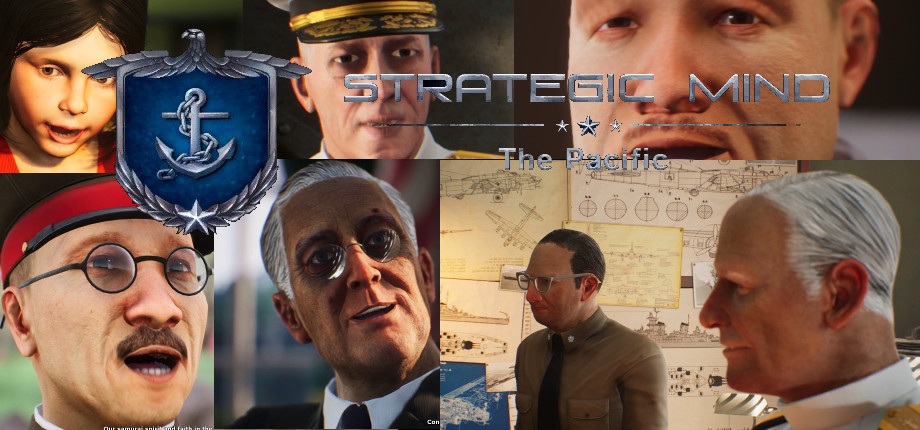


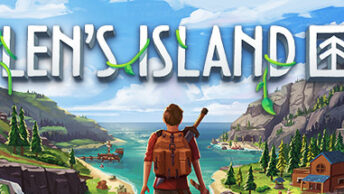


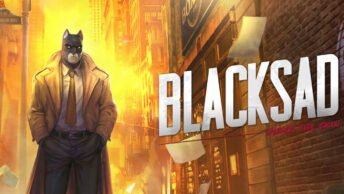



Hello. I am a developer from Starni Games. Thank you for the long and detailed article on Strategic Mind: The Pacific. You are free and welcome to express your thoughts. We are happy that overall it seems you have enjoyed the game – an that is what matters. Yet your article has a number of factual mistakes, which I can point out if you are interested. I will start with the Historical part: the episode with Nagumo is described by Japanese bibliographists (Look up the book “The Reluctant Admiral: Yamamoto and the Imperial Navy” published in 1979 in Japan), as well as geisha Kawai Chiyoko (hell she is even on the wiki article about Yamamoto, you do not have to look for a rare book Here is the quote from Wikipedia “He and his wife, Reiko, had four children: two sons and two daughters. He enjoyed the company of geisha, and his wife Reiko revealed to the Japanese public in 1954 that Yamamoto was closer to his favorite geisha Kawai Chiyoko than to her, which stirred some controversy.[33] His funeral procession passed by Kawai’s quarters on the way to the cemetery.”) Also note that his wife was in another town/village with the family, while he stayed in Tokyo, where the Kawai Chiyoko was living. The Sumo wrestler line is an actual quote. And Yamamoto did order Nagumo to attack Midway which he declined on the pretense of bad weather (but my guess would be due to fear to lose more planes). (See the book above). Regarding that, the script was written by a person unfamiliar with Japan: I was In Japan twice, studying Aikido and passed an instructor’s test to the Japanese master (Tsutomu Chida Sensei), allowing me to conduct tests up to the black belt. So, I am acquainted to quite a lot of Japanese people and know a few things about their country, history, and traditions. We have also conducted extensive research, besides reading through the Yamamoto`s biography book (see above). I have to admit that the information on the subject is harder to find than for the USA though, due to obvious reasons. There are also some plain wrong statements about the actual gameplay: in fact, all cinematics are pre-rendered(you can find videoes in the game folder); AI follows the same overwatch rules as the play, in fact, all mechanics for AI and the player are the same. (Overwatch works an unlimited number of times only against recon planes, which is noted in the corresponding HQ skill.) Also, there is a level-up skill that gives more than 1 overwatch per turn) Good luck with further articles
With best regards
Oleksandr Sienin